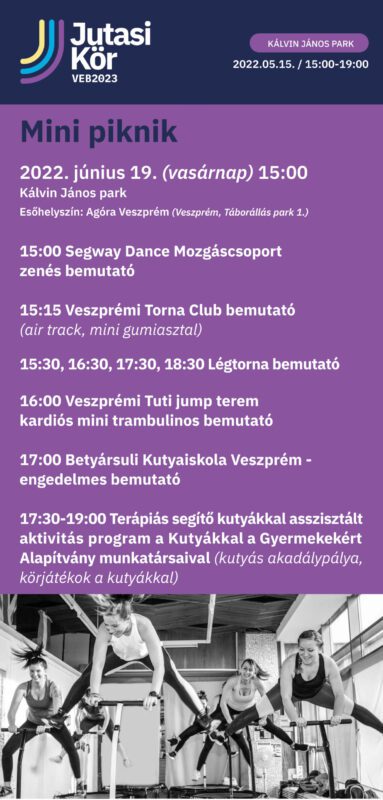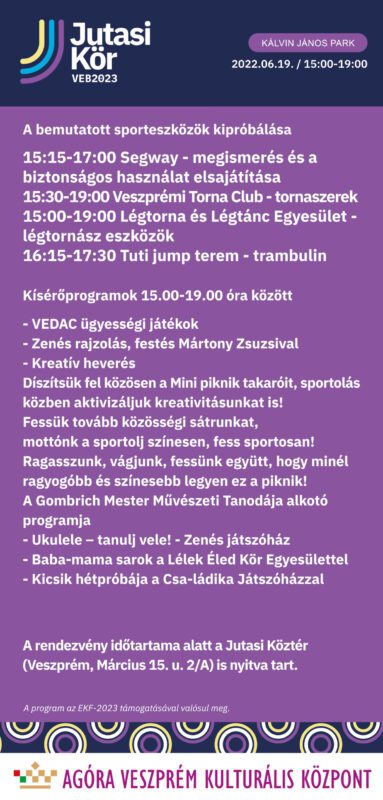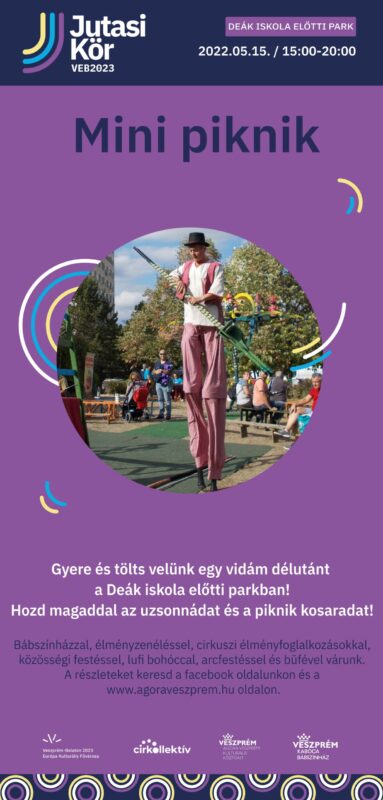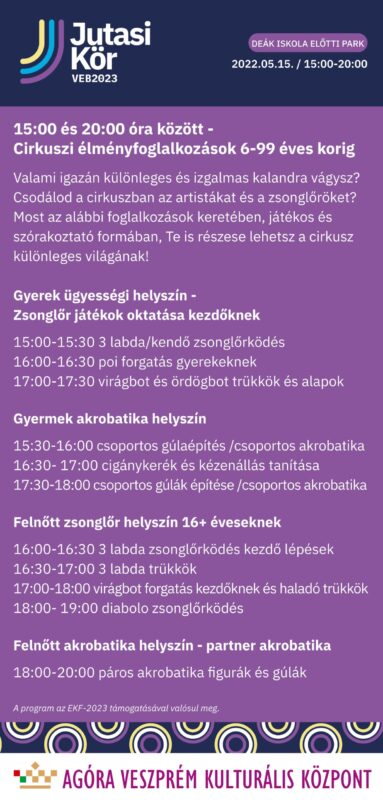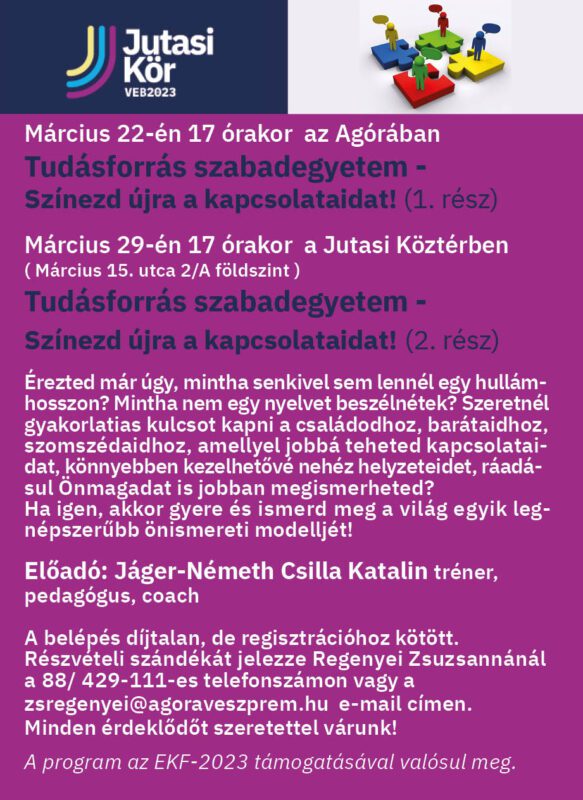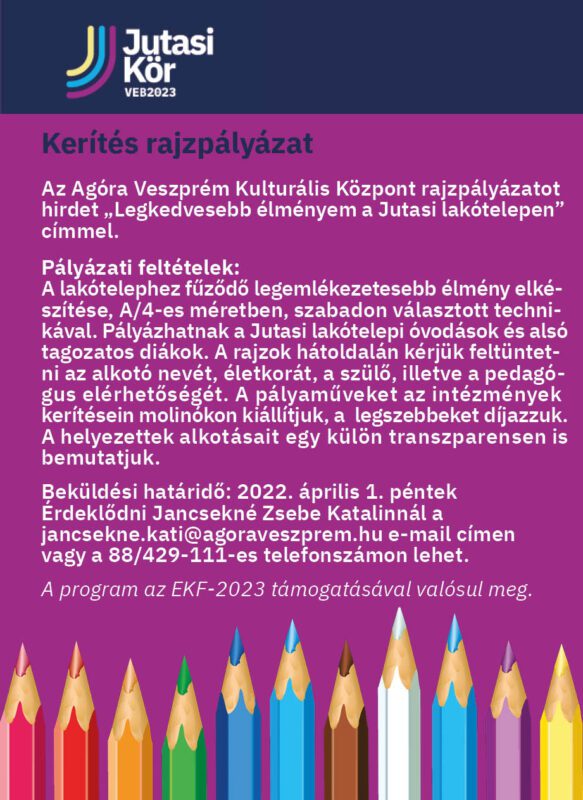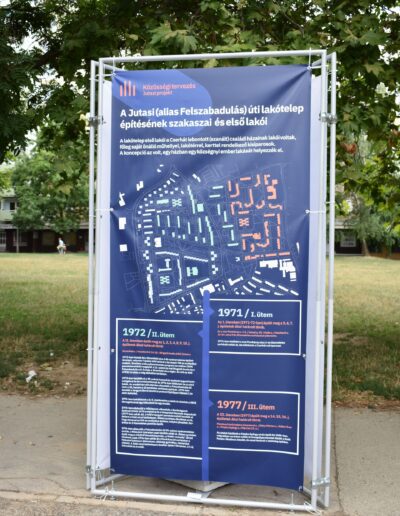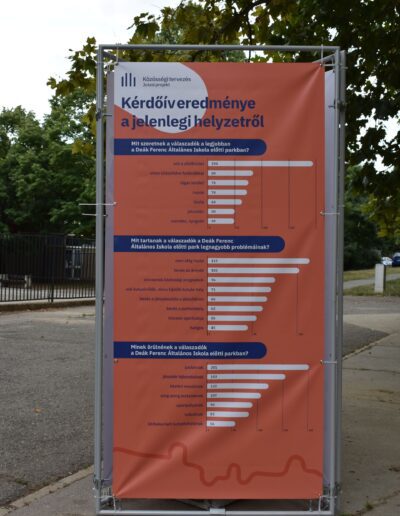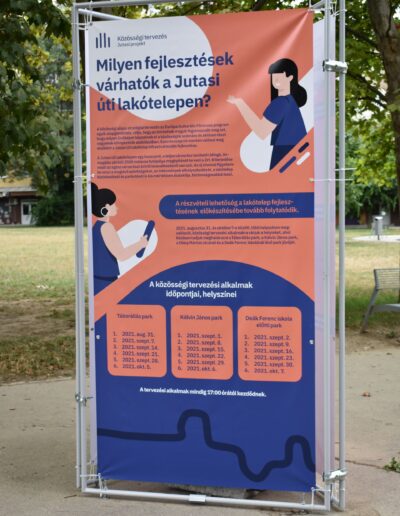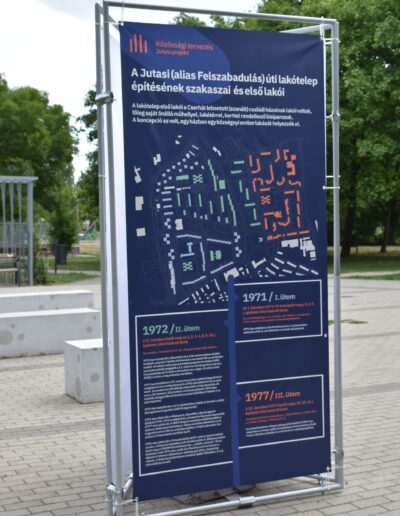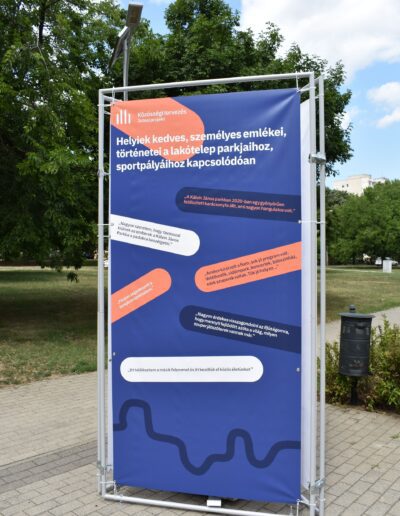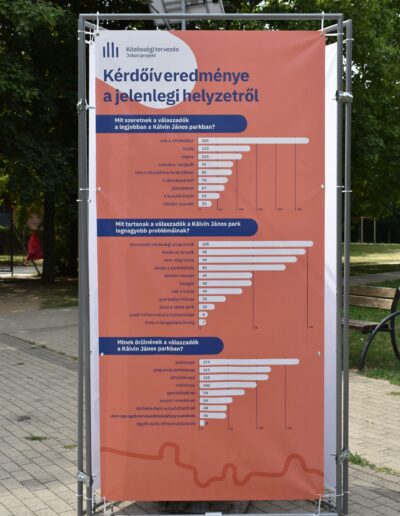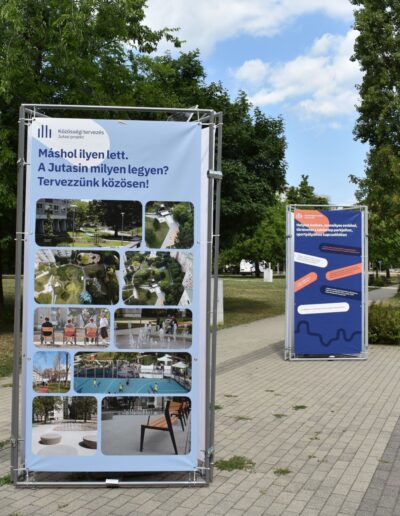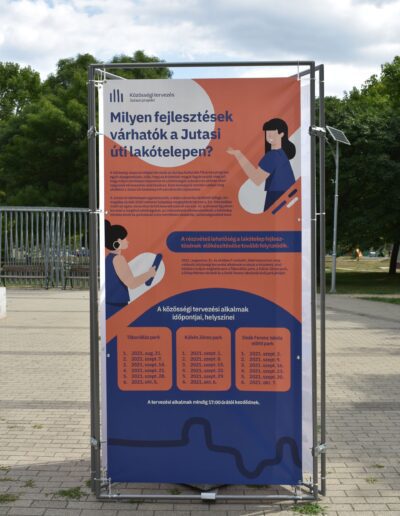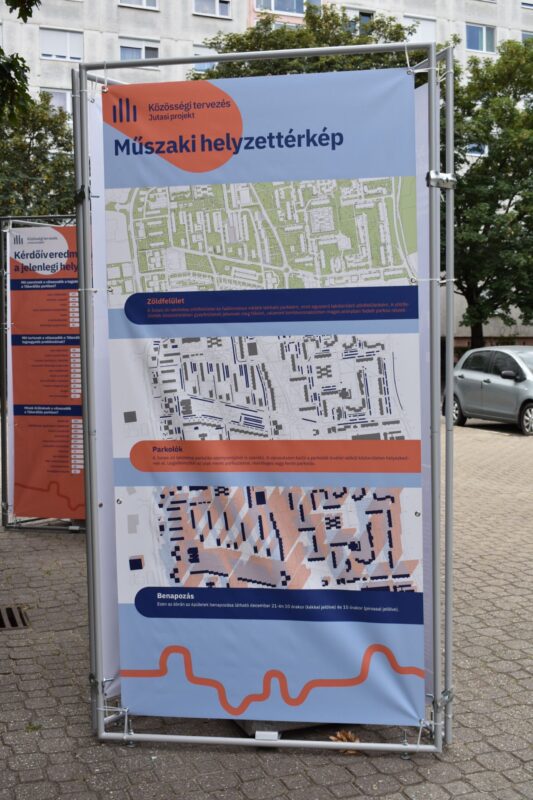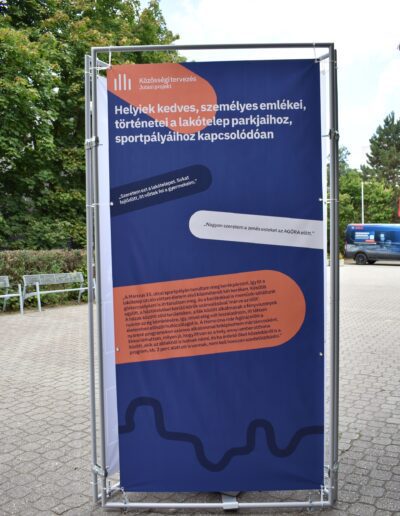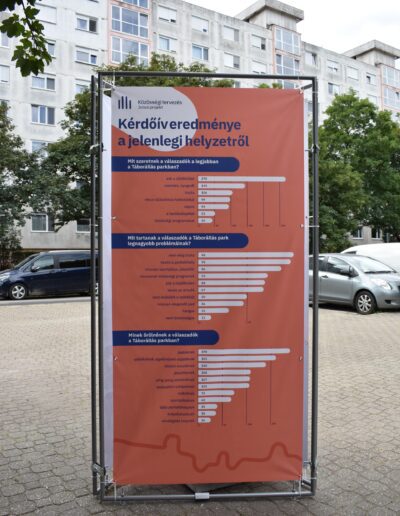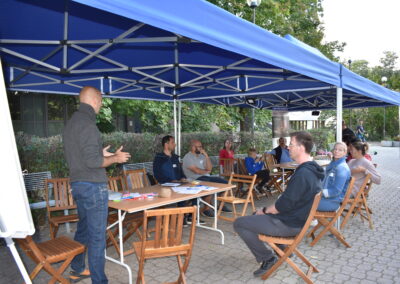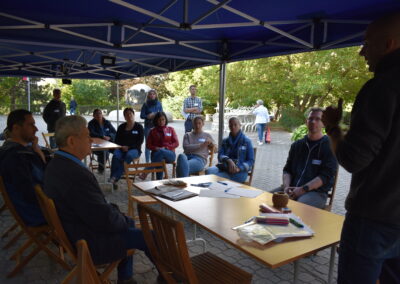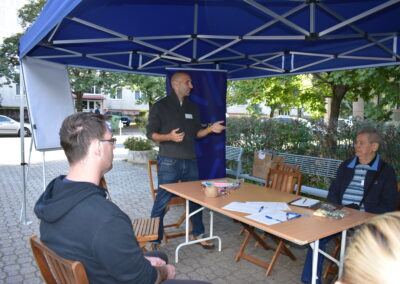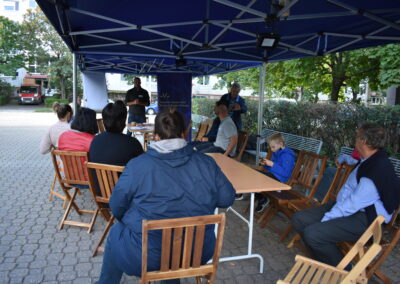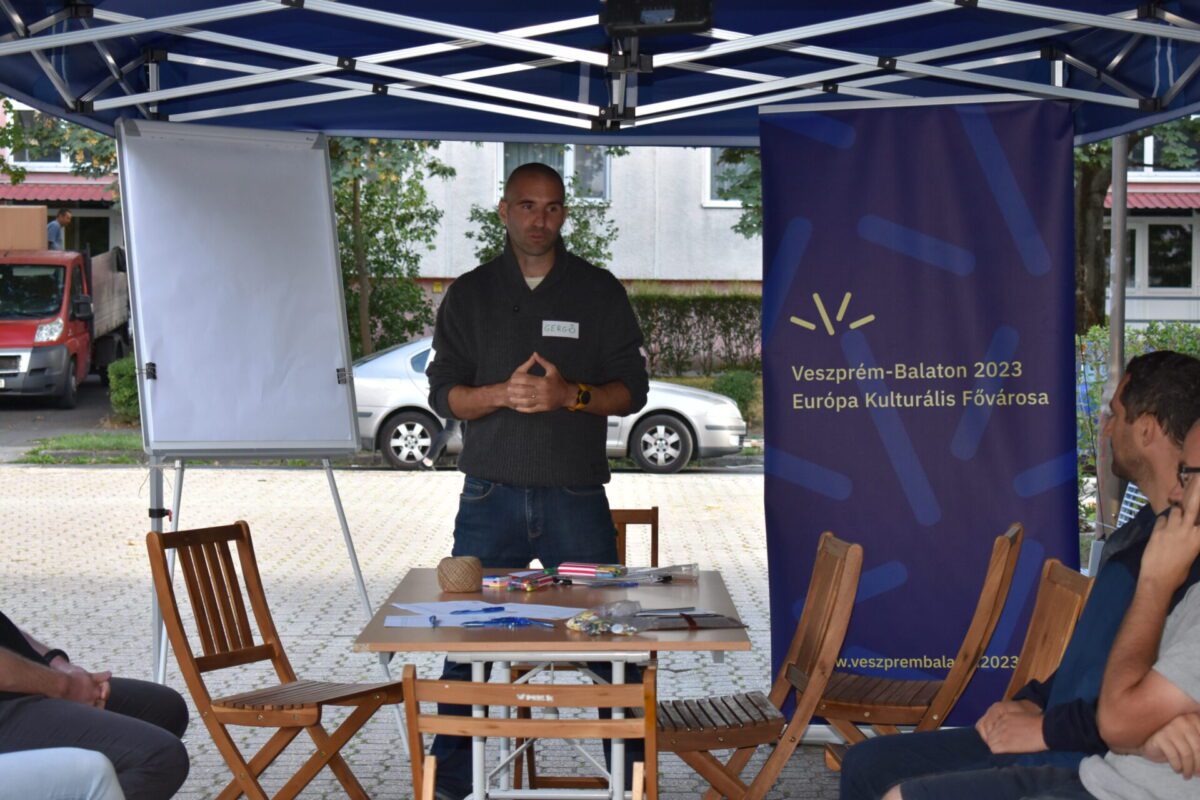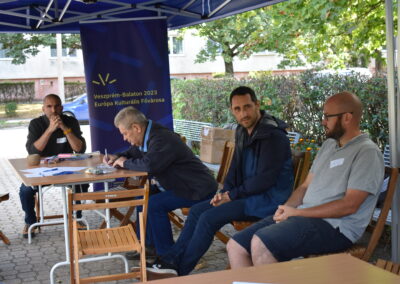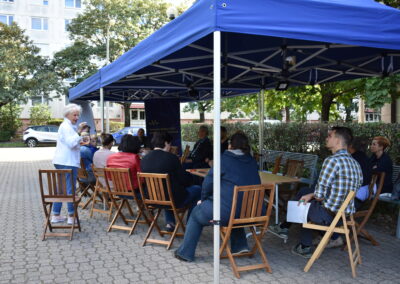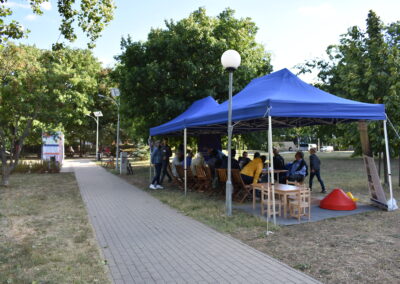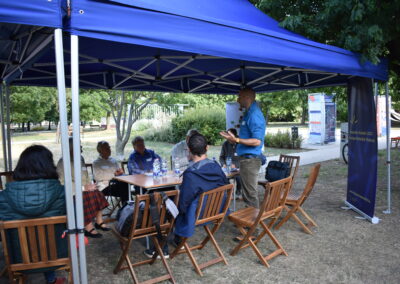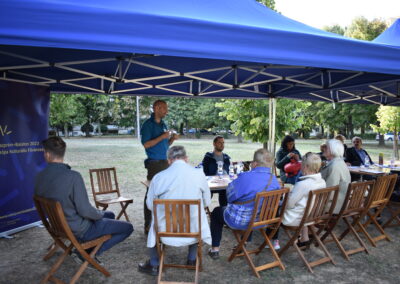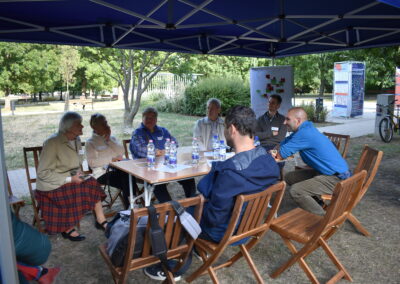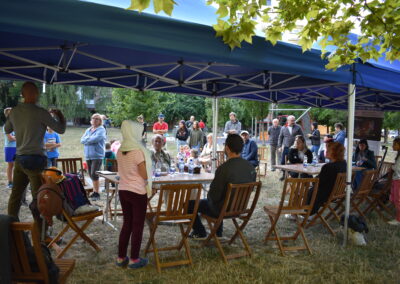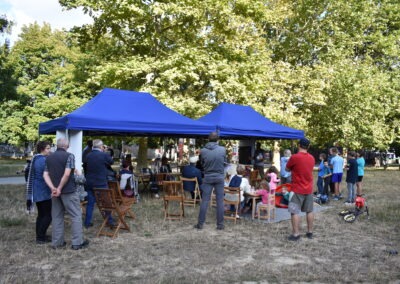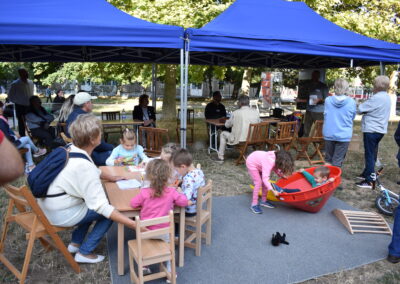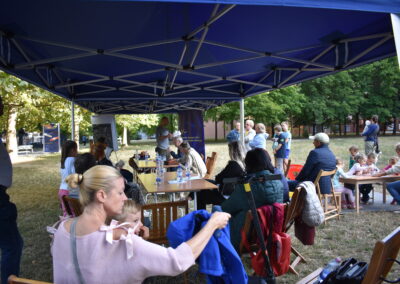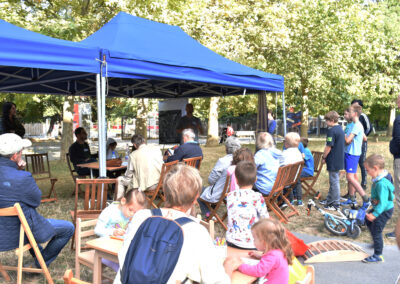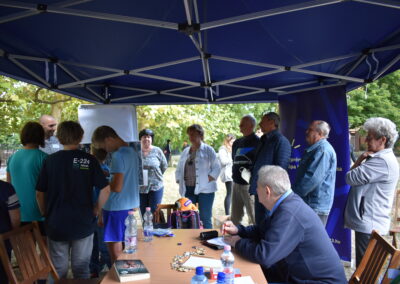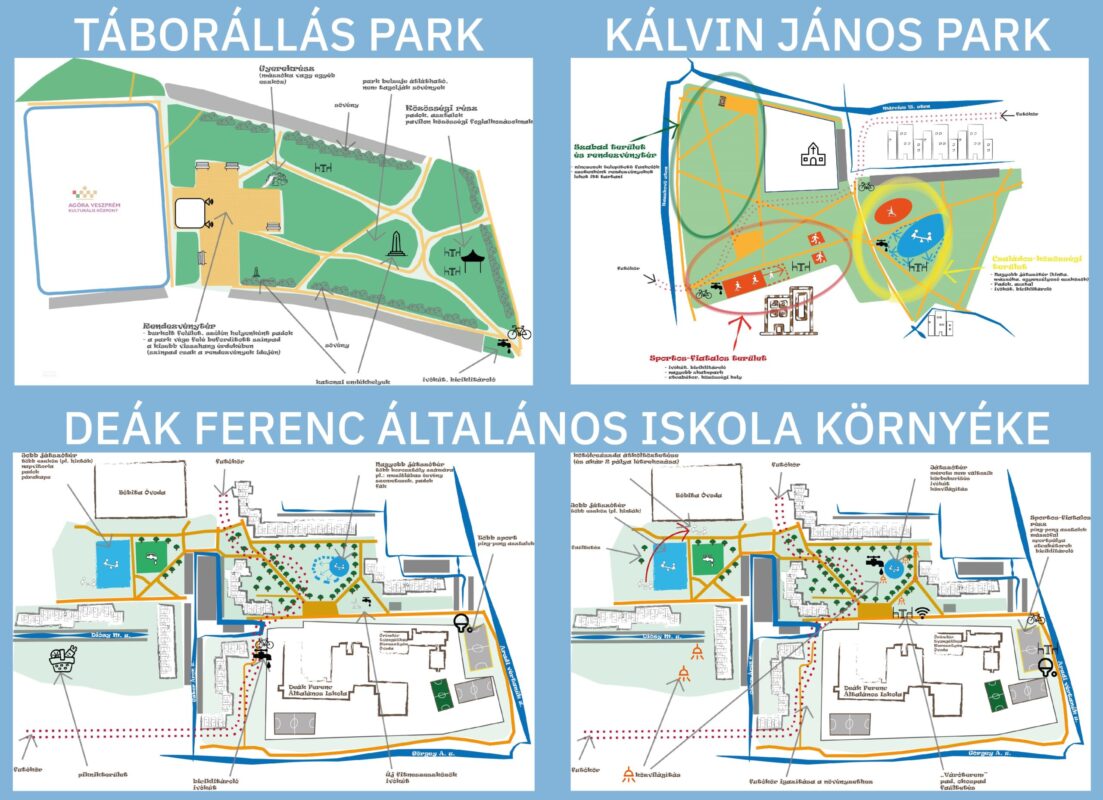Community planning and development in the Jutasi Road housing estate
OC-MUV/4-2022/413439 -
III Jutasi Picnic and Olympics - Community development in the housing estate
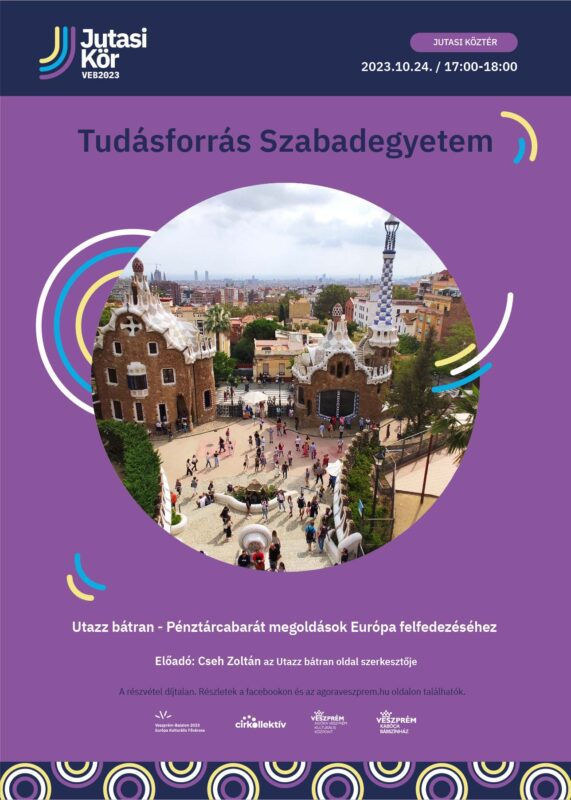
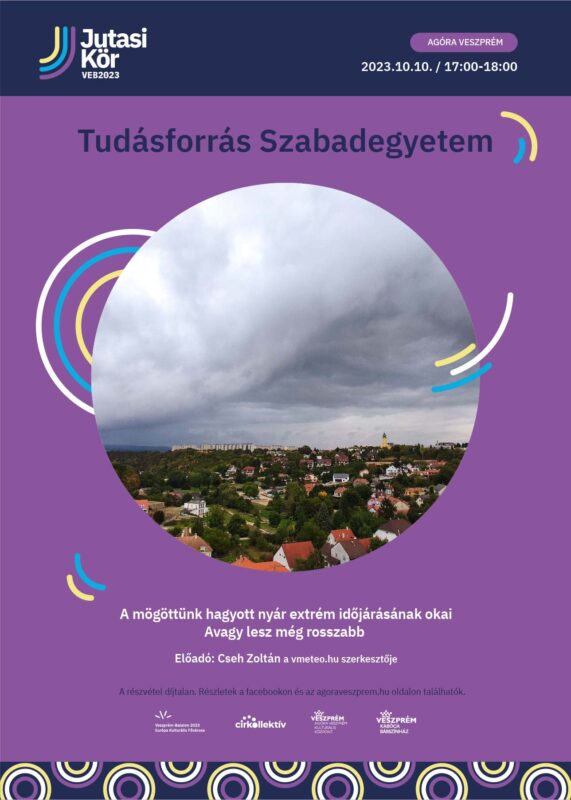


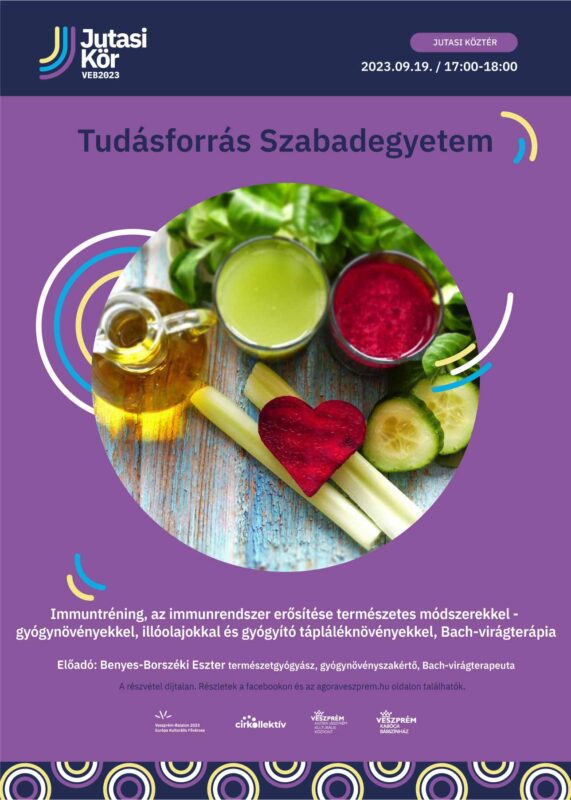
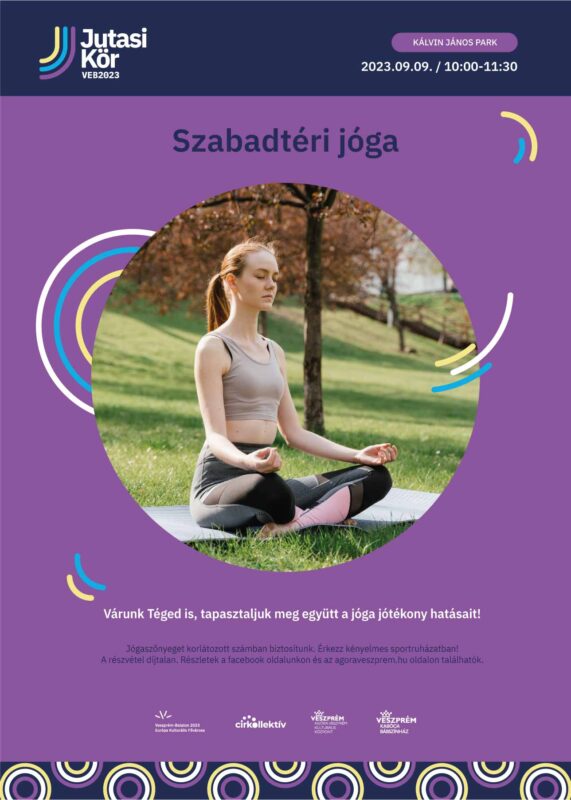
III Jutasi Picnic and Olympics - Community development in the residential area - OC-MUV/4-2022/413439


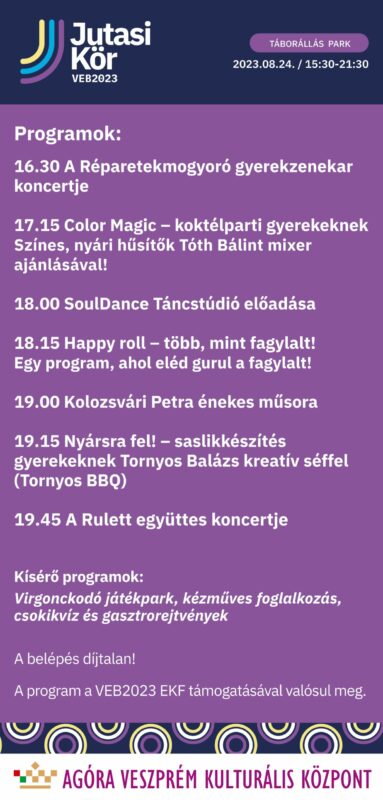
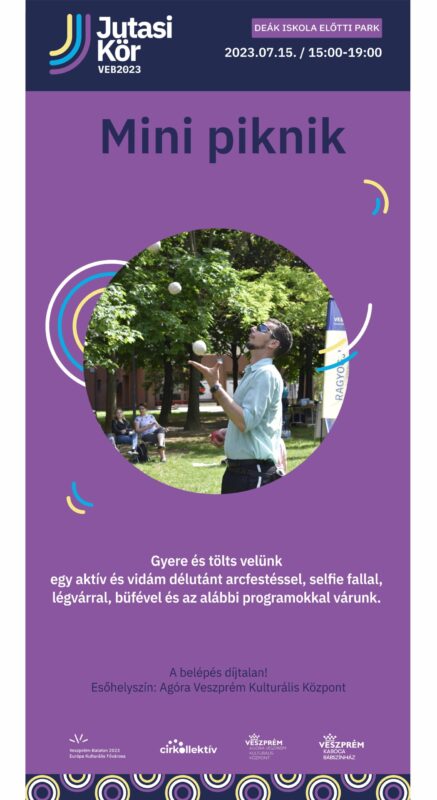
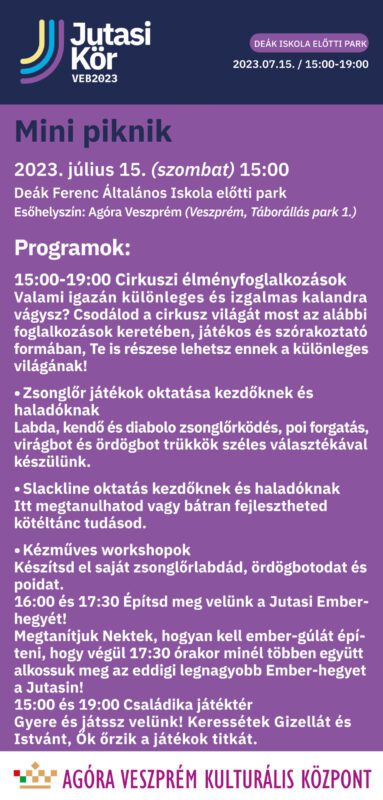
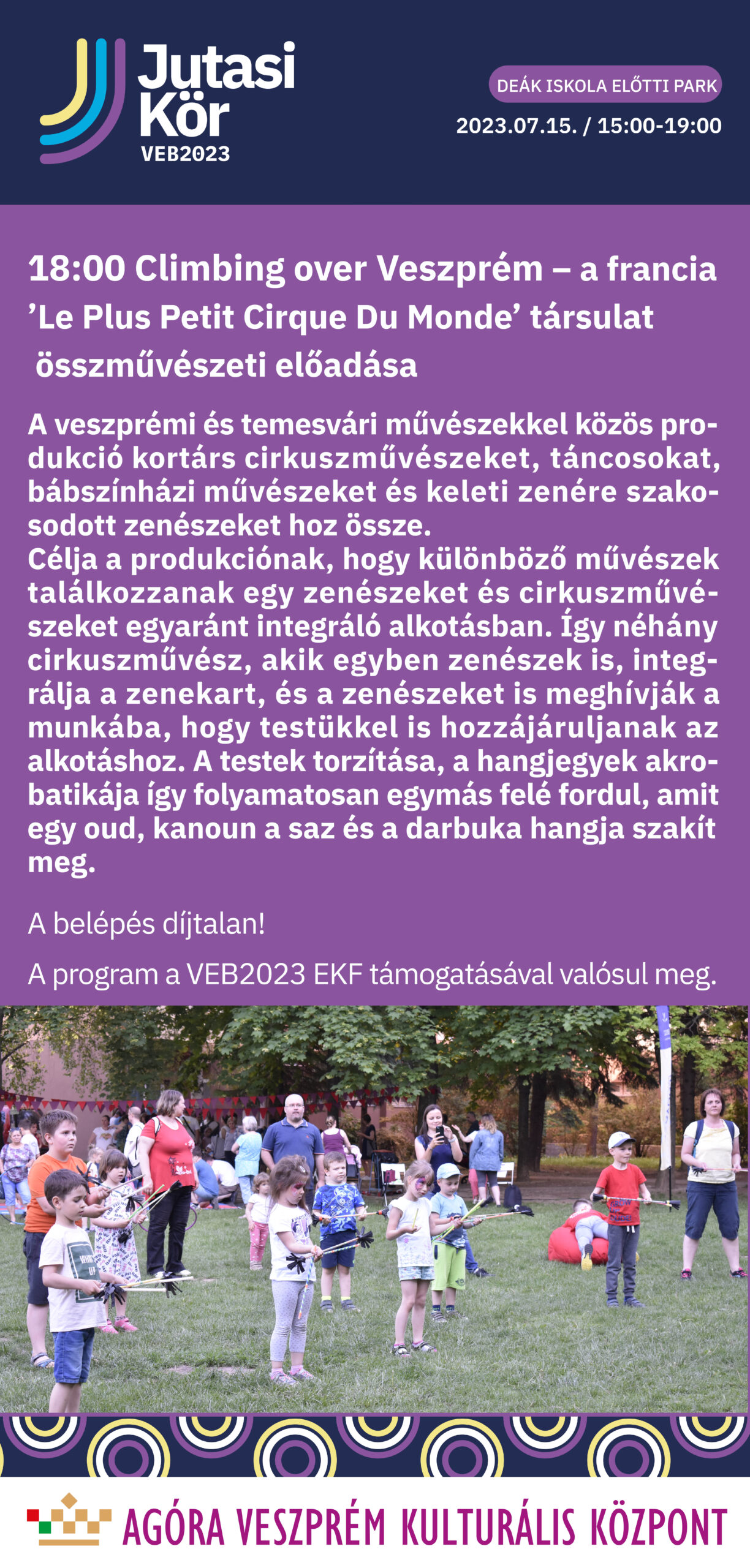
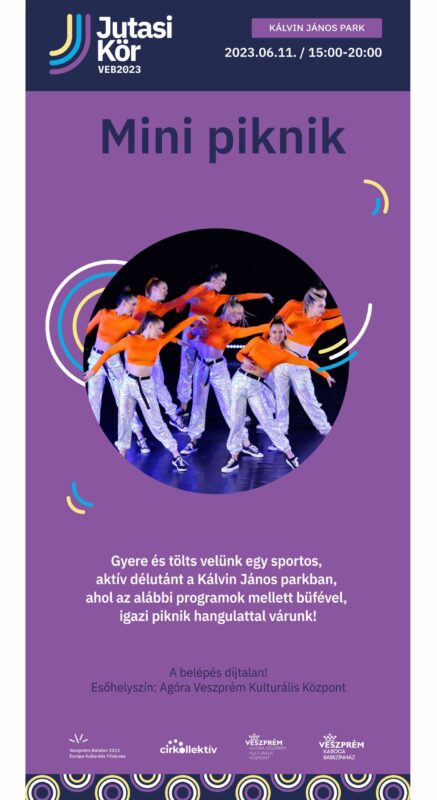
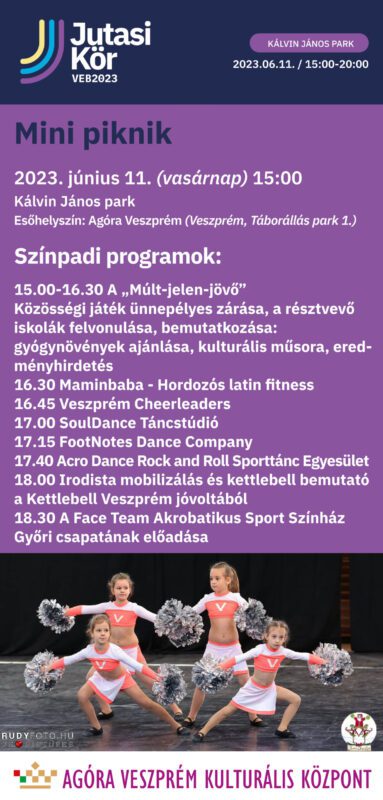
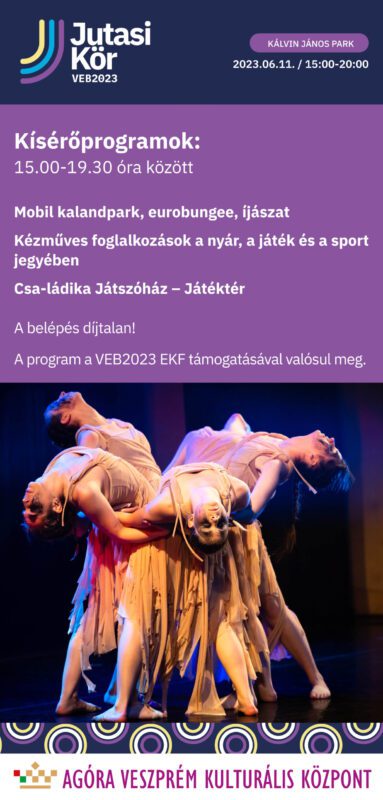
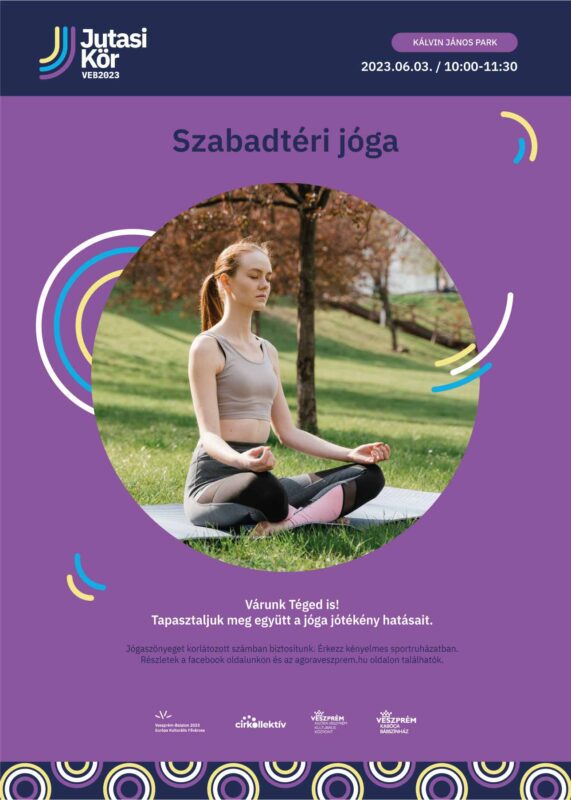


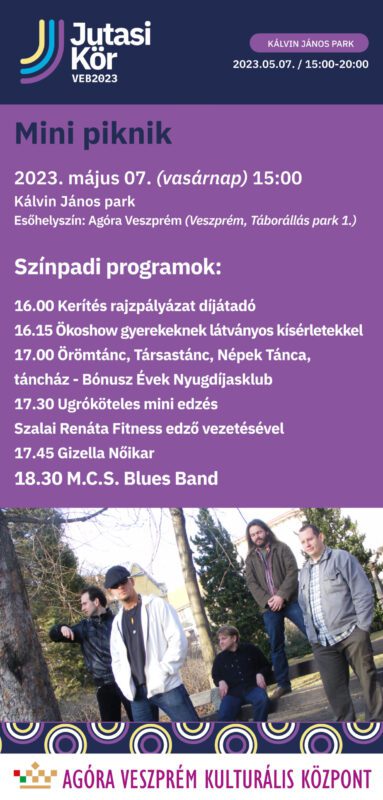



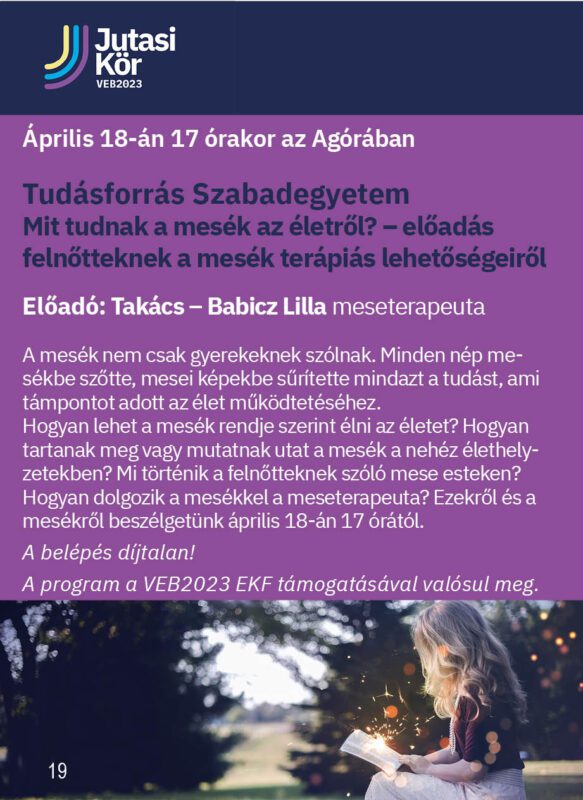
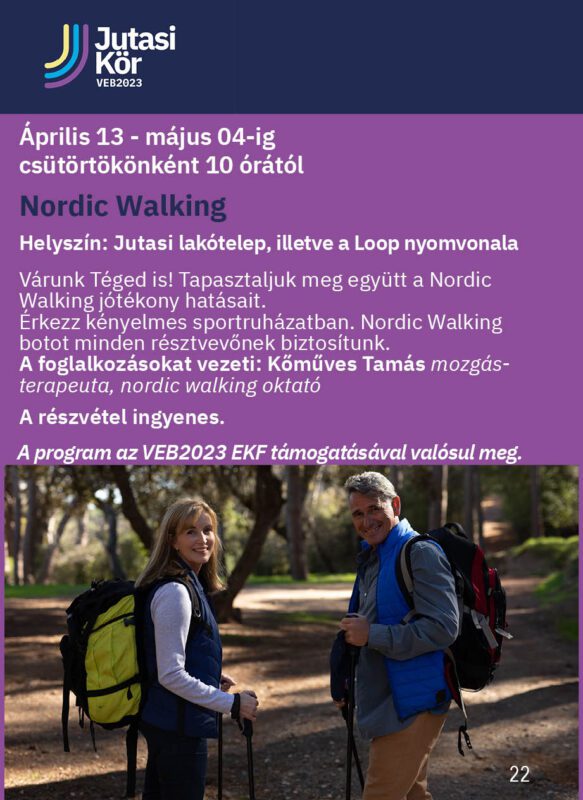
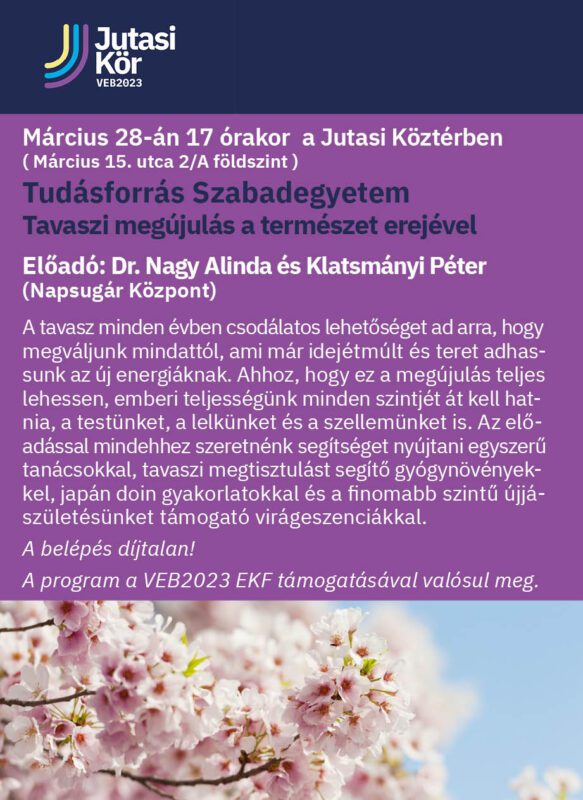
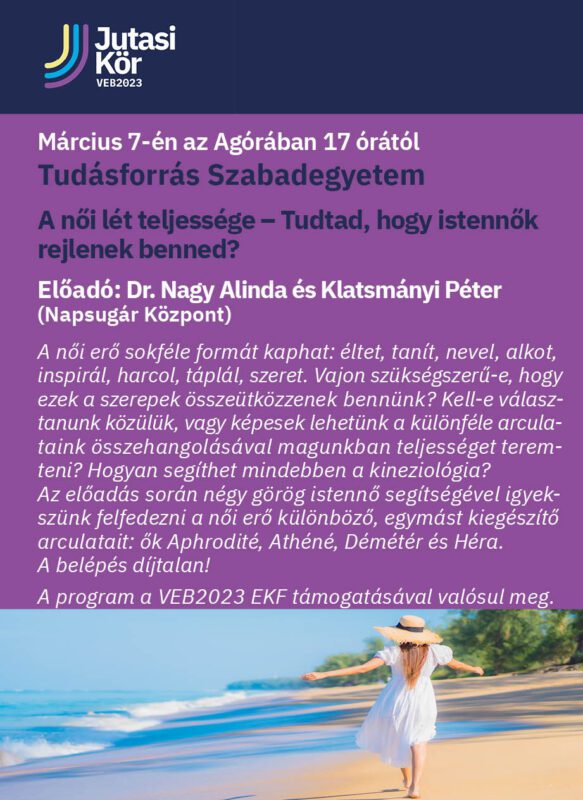
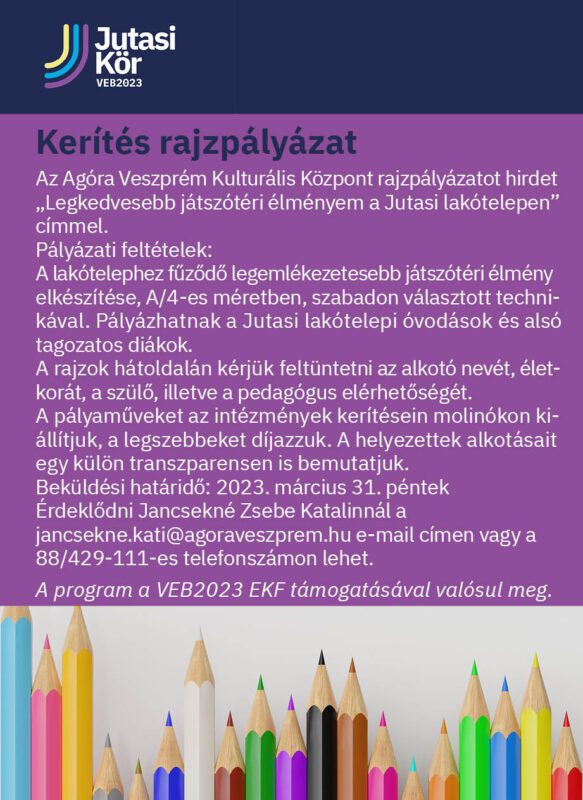
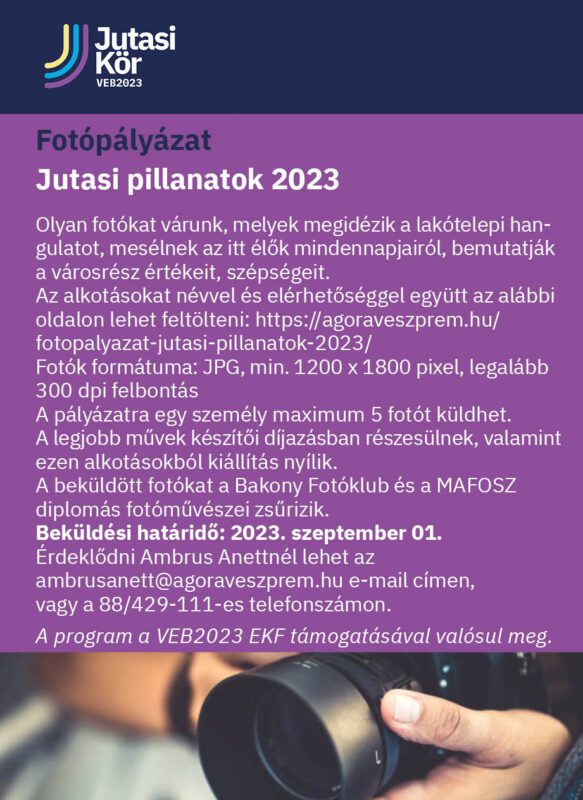

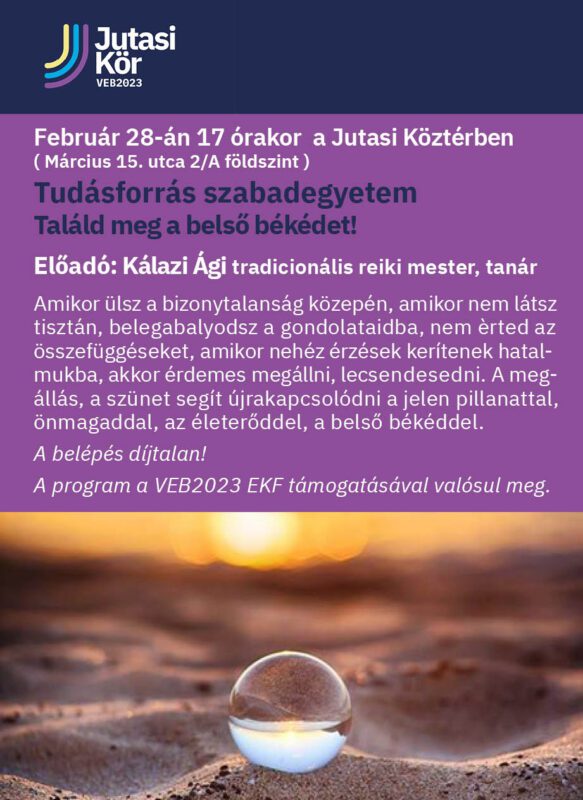

II Jutasi Picnic and Olympics - Community development in the Jutasi Road housing estate
The project included lectures at the Free University, a drawing competition, an asphalt drawing competition, community games, space-use programmes, photo and sound collection, mini picnic events and the three-day Jutasi Picnic.
Each day the Picnic had a different theme and a different location. Circus activities and other community events took place in the park in front of Deák School. In János Kálvin Park, there were sports and movement activities, skill demonstrations, craft activities and concerts.
Due to the bad weather, we moved the gastronomic events, puppet theatre productions, family and children's programmes to the Agora building instead of the Táborállás park.
The events were attended by schoolchildren, kindergarten children, young people and adults from the housing estate and other parts of the city.
We also partnered with communities in Agora, speakers, educators, artists, sportspeople, musicians, and entrepreneurs providing play parks and other facilities. The programmes have added colour and meaning to the cultural, artistic and community life of the residents.
The number of visitors reached nearly 4000.
The programmes are part of the call for proposals OC-MUV/3-2021/868454,
were implemented with the support of the VEB 2023 ERDF.
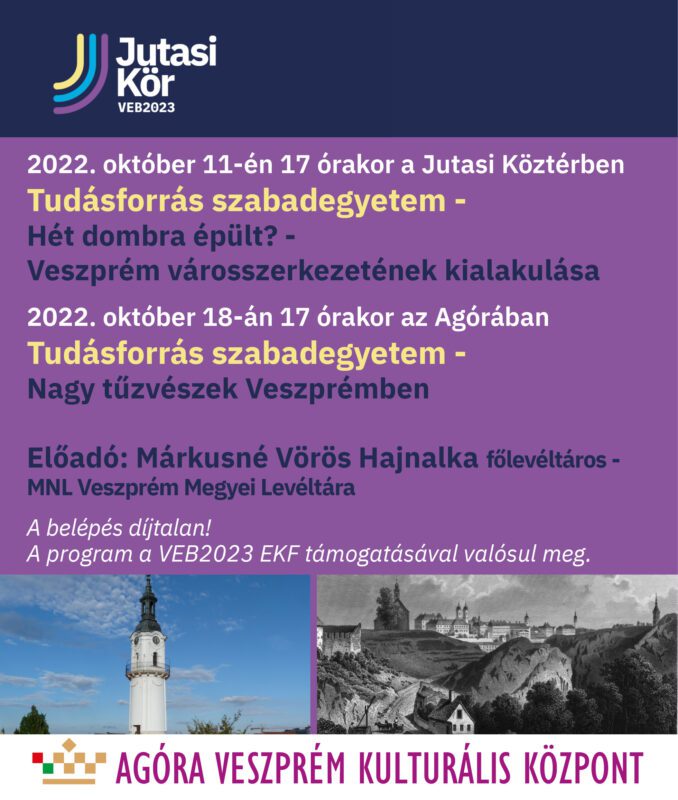
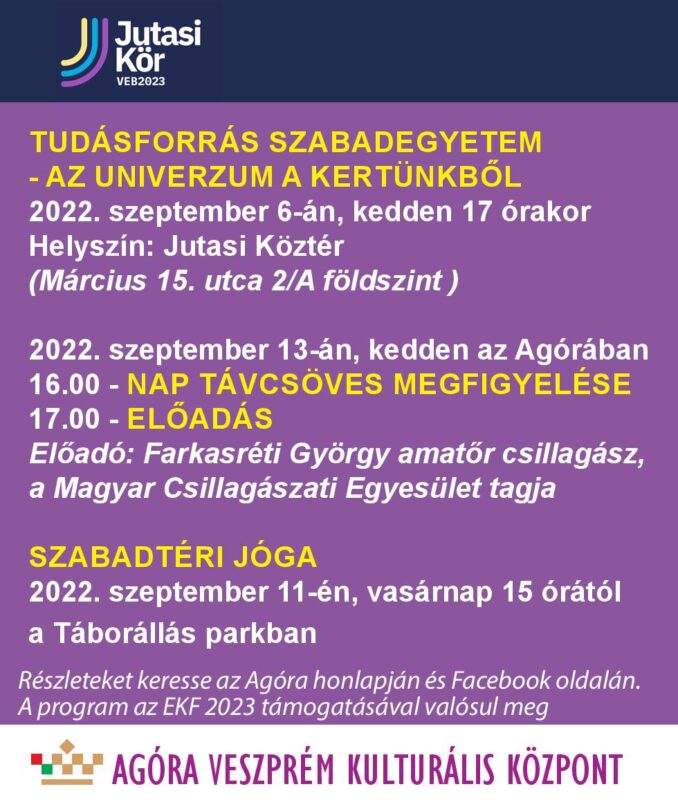
Mini Picnic 2022.August 14.
Mini Picnic 2022 June 19.

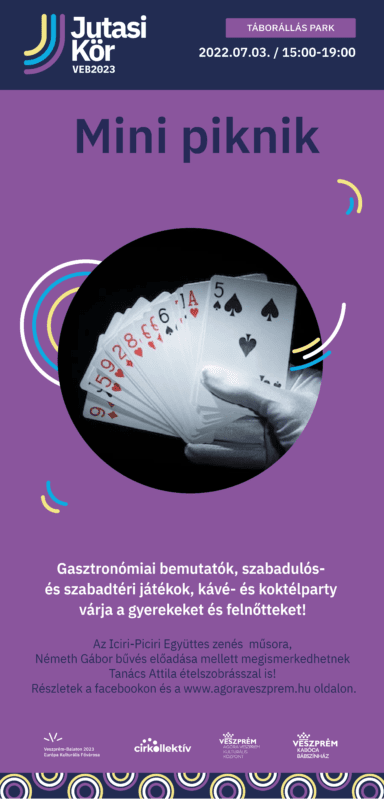

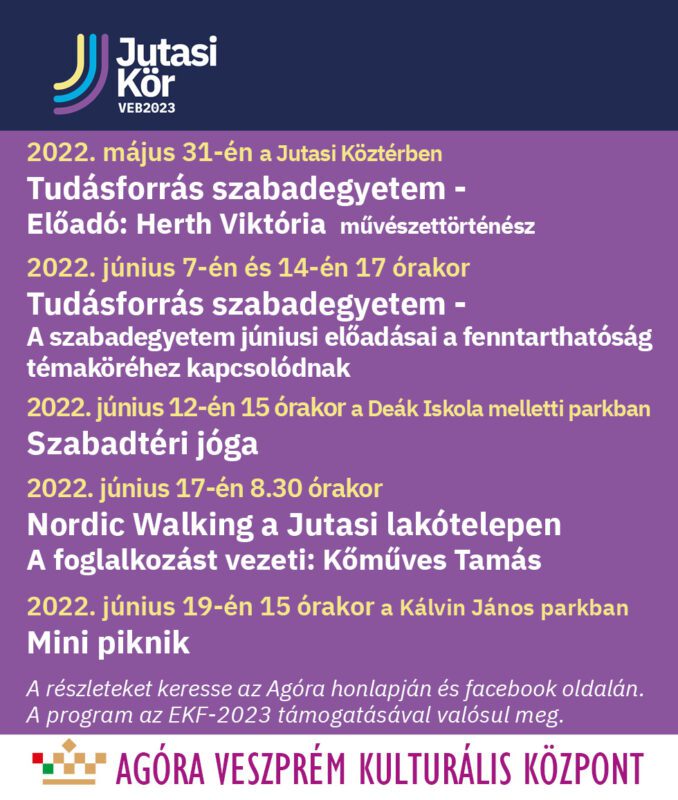
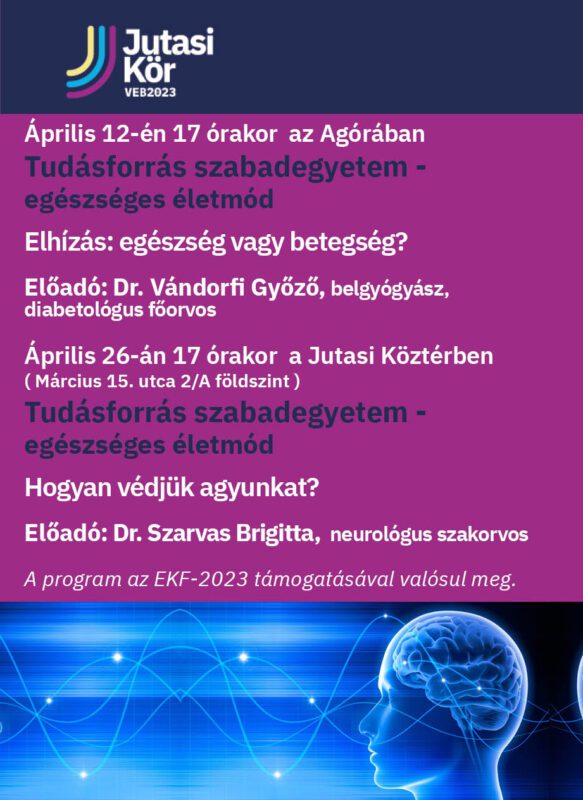
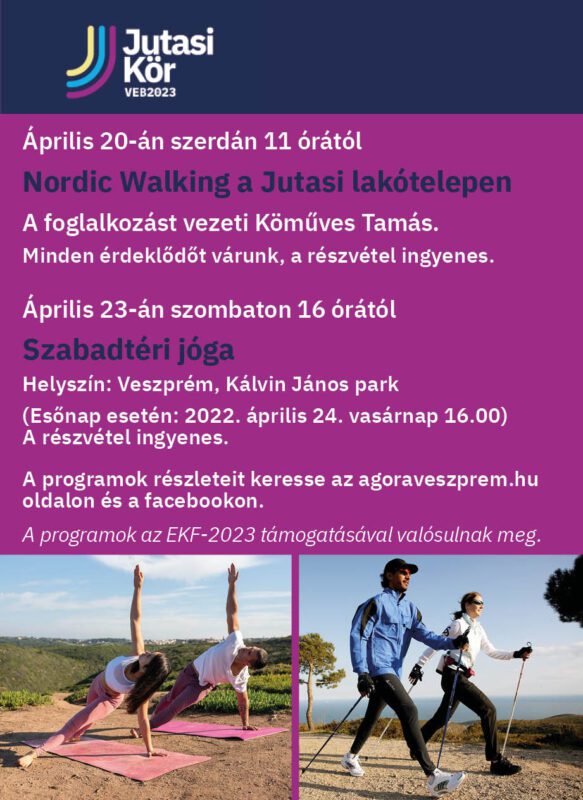
Community planning in the Jutasi Road residential area - OC-MUV/1-2021/4852
In preparation for the EYF year, we would like to launch a community-building activity, a community planning process, in which we will propose infrastructure interventions by actively involving the residents of the Jutasi Road housing estate.
Our aim is to create a living environment where people feel at home. Our activities are always guided by the values and objectives of the EFF. We strive to preserve cultural heritage, strengthen local identity and cohesion, encourage the creation of self-determined groups and promote intergenerational dialogue.
Our primary target group is the people living in the housing estate, but the regenerated estate will also benefit the city and the region in cultural and economic terms. Community involvement reflects the mission of the EFC and Agora.
The exhibition is out now!
There are 3 locations: in front of the Táborállás, in front of János Kálvin and in front of the Deák Ferenc School.
Experiences of community planning sessions
Campsite park /08.31./
On 31 August, people started arriving before the advertised 5pm time to attend the community planning session on Campsite Park. The meeting was held outdoors, under the shelter of tents set up in front of the building, so we could take a look at our planning area at any time, and also allow passers-by who had not originally come to us to join us.
As our moderator said in the introduction, we were attending the first meeting of a six-session community planning session. We were briefly introduced to the background - the EDF programme itself, the development ideas for the Jutasi Road housing estate (such as the "Loop", the 3.5 km running circuit that will encircle the whole estate) and the survey that was held earlier this summer.
After the introductions, each participant said a few words about themselves and their relationship with the area. Some people came from the house next to the park, others from other parts of the estate, and others who don't live here but who commute through the park every day for work. As the turnout was lower than expected, one of the largest groups was the Agora residents, who of course actively use the area not only as private individuals but also as institutions.
The main aim of the first meeting, apart from getting to know each other, was to talk about the use, values and problems of the park. At this point, we used the results of the questionnaire to put on the board, one by one, the positive and negative points made by the 526 people who completed the questionnaire. It was immediately apparent that their answers contradicted each other in places. Some praised the cleanliness of the park, others criticised it. Some found the park quiet and peaceful, while others found it noisy. The green spaces were seen as an asset by most, but one of the biggest problems was the lack of parking spaces - significantly, these are areas that can only be expanded at the expense of each other. The questionnaire therefore highlighted issues that were definitely worth discussing, so we started to talk about them.
It was agreed that at present the park is mostly used for transit, and that few people would want to sit here on a typical weekday. This is partly due to the "openness" of the park - it does not provide a protected space that would encourage people to stay; and partly due to the problem of homelessness, which was also mentioned in the questionnaire, as a factor that makes people reluctant to spend more time in the park. The exception to this is, of course, when Agora uses the park for an event, when the park is really full. At these times, the volume of the programme can be a problem, and although no event is likely to last longer than 8.30pm, it is hoped that the renewal of the park will see the stage oriented in such a way as to significantly reduce the echo effect. The main aim, according to the participants, would be to enhance the recreational character of the park, preserving the valuable plant life and creating an intimate but transparent park where it would be a pleasure to come down from the houses in the neighbourhood, even if only for a quiet sit and read. This was the conclusion of the meeting.
In the next session, we will talk about the features and solutions that could be used to achieve this goal, and how to imagine the "Loop".
We encourage everyone in the area to come to Campsite Park at 17:00 on September 7 and have your say in shaping the plans!
János Kálvin Park /09.01./
On 1 September, we held our first planning session in John Calvin Park, focusing on the use of the park and mapping the value issues. The meeting, which started at 5pm, was mainly attended by older people from the area, but fortunately they also had a deep knowledge of the areas used by younger people.
At the beginning of the meeting, we briefly reported that we are at the beginning of a six-event planning programme, which could be implemented within the framework of the Veszprém-Balaton 2023 European Capital of Culture. We talked about the planned developments in the Jutasi út residential area, such as the 3.5-kilometre running circuit, the Loop, the point-to-point infrastructure improvements, and the community planning programme that will be implemented in three areas, Táborállás Park, Kálvin János Park and the area around Deák Ferenc Primary School in the coming weeks.
Then the participants were introduced. Unfortunately, the number of local visitors was not very large, mainly from the buildings around the park. A common feature was that they walk in the park several times a day - walking the dog, meeting friends, sitting around. Almost all of them also had experience of the playground or skateboard park through their children or grandchildren. However, there were also visitors who live further away but often pass through John Calvin Park.
Perhaps not surprisingly, although all participants had some critical comments, satisfaction with the park dominated the discussion. The proportions of the park, its green cover and the alignment of the paths seem to be basically adequate. The features are not intrusive, and could be even larger if there was a demand for them (especially for the skate park), if this could be achieved without cutting down valuable trees. There is always room for shaded and sunny benches, but many people would like to see seating facing each other, sometimes with tables, to provide a communal space for a group of people. The biggest problem is the users themselves - litterers, dog walkers leaving dog waste behind, for example. Water was a recurring theme: many people would welcome a drinking fountain, some even a fountain. Most of the participants missed the lack of a functioning public toilet, which some park users use to do their business in the bushes. However, the increasing number of events in recent years was welcomed, although it was also mentioned that parking in the area becomes very difficult during these events.
We said goodbye to each other, discussing values and problems, and agreed to talk about future visions at the next meeting. We hope that more people will attend the meeting, as it will be possible to plan the best possible park by listening to different points of view.
See you on 8 September at 17:00 in János Kálvin Park!
Park in front of Deák Ferenc Primary School /09.02./
On 2 September, we met with local residents in the park in front of the Deák Ferenc Primary School to discuss the development of this part of the estate. The choice of location was ideal, as it allowed not only those who had made a note of the time to join the community planning, but also those who had come to the playground, to walk the dog, or to hang out with friends after school. Because - to our great delight - many teenagers joined in, and they were the bravest, setting an example of enthusiasm to the older ones. Fortunately, the latter also turned up in good numbers, so it is fair to say that all ages were well represented.
As in the case of the other two parallel designs (Táborállás and Kálvin János Park), we started the meeting by presenting the design framework. It was explained that the community planning is being implemented within the framework of the Veszprém-Balaton 2023 European Capital of Culture (ECOC) programme. We also briefly discussed the general objectives of the ECF, and then we turned to what directly affects the life of the housing estate: the 3.5 km running circuit to be implemented next year, the spot development interventions affecting the whole estate, and thirdly (and primarily) the subject of our community planning, the so-called "Veszprém-Balaton-Balaton". "sub-centres". Of the three sub-centres, one is the two parks in front of the school and the other behind the nursery school, the subject of our community planning. The aim of the six weeks of joint work is to produce a plan for their future based on the experiences and ideas of the people living in the area, and on which the various park users can reach a compromise.
The introduction was followed by a discussion that was both an introduction to the locals and a collection of their experiences of using the system. At this point, the 10-15 year olds proved to be the most proactive. The young people said that they love the park and spend a lot of time here - partly as part of lessons, as physical education is often (also) held in the park, but also after school they often stay to play in the playground or play football on the grass. Inspired by the schoolchildren's example, more and more people have spoken up and given their own opinions, and the results of a survey of the area - on problems and values - were shared with us earlier this summer. These are presented below, by theme, together with some of the ideas that emerged from the discussion.
- DESTINATION
As the results of the survey showed, the greatest value of the largest park for the residents of the area is its green spaces. This is something that it is essential to preserve for the future. There were some critical comments about the maintenance of the park, and several people pointed out dead trees that might be overdue for replacement. In addition, areas where the installation of utilities has caused the grass surface to become sunken and accident-prone.
- PARKING AND CAR TRANSPORT
A major problem in the area is the difficulty of parking. For car owners, finding a parking space near their home is a daily problem in the evenings, so there were contributors who would even sacrifice small green spaces to create new parking spaces.
A neighbourhood-specific parking and traffic problem is the congestion caused by parents driving their children to school. It has been said that in the mornings the area is flooded by such drivers from all directions and, in the absence of a proven traffic management system, chaotic situations are created, to the detriment of both the 'causers' and the people in the area on their way to work.
There is also a problem with the presence of goods vehicles in the residential area. A proposal has been made to designate a parking area specifically for them.
- JACOTAGE
The playgrounds in the two parks are loved and accepted by the locals, according to the questionnaire. The same is confirmed by the comments made at the meeting, but of course there were many comments for improvement - for example, there are not enough swings, fencing could be considered, there is not enough play equipment, the equipment is not always used as required... and there are many more. Clearly, an important theme for future occasions will be to improve this feature, which is shared by the school's students and residents of the area.
- MISSING FEATURES
Missing features and infrastructure elements that would be needed have also been identified. These are also grouped together:
o sport
It does not seem realistic to build a sports field (football pitch, etc.), as this would lead to conflicts between the houses, and would only be built at the expense of green space. However, there would be a demand for the function, and it was suggested that this could be remedied by improving the infrastructure (e.g. lighting) of the school pitches or the pitches next to the school, or by opening up the school pitches for public use. The latter, of course, is not feasible without the involvement of the school, so their views on this will need to be sought in the future.
Several people said they would like to see outdoor fitness equipment, preferably of the type that offers opportunities for older people to exercise.
We also mentioned here the ring road that is being built, which will also affect this area.
o street lighting
The lack of street lighting was also a problem - not only because it makes it difficult to cross, but also because it reduces the feeling of safety.
o Water
There is a drinking fountain only in the park behind the kindergarten. Once the running track is in place, this will be in particularly high demand.
o community-building places
Currently, benches are scattered along the promenades, offering a place to sit. Many would like to see areas where people can sit down to chat on facing benches, seating or even take a seat at chess tables. In addition, often, especially after school, the number of benches currently outside is in short supply and they are quickly taken up by students and bags.
- DOG USE
Many dog owners also attended the community planning session, and they too said (as was evident from the questionnaire) that unfortunately there are still some owners who don't pick up after their pets, and that it is not easy to find an area where dogs with higher exercise needs can be exercised. This problem will also be discussed at future meetings, but the good news is that, as we learned from the councillor present, part of the area across Görgey Road has been included in the city's green space strategy as a potential dog run area. If funds are available, the construction of the appropriate infrastructure could add an important feature to the area around the housing estate.
- IMPROPER USE
Another problem is that with the onset of cold weather, more and more people are moving to live in the park area and the bottom of the housing estate. This is, of course, a social issue that goes beyond community planning, but it will be important to discuss what planning tools can and should be used to respond to this situation.
- maintenance
There were also criticisms of the reservation. Although community planning is essentially focused on development issues, these comments will of course also be passed on to the relevant authorities, and we will have to strive to design public spaces that can be operated well, economically and sustainably.
After discussing the above, we parted with the participants that we will get to know the ideas and plans for the running track in detail at the next meeting. As far as the parks are concerned, the focus will now shift to finding solutions after the current "problem gathering".
We are waiting for everyone next week, on 9 September at 17:00 in the park behind Deák Ferenc Primary School!
Campsite park, second time /09.07./
On the afternoon of 7 September, we gathered for the second time with local residents to talk about the development of the Campsite Park. This time, we set up our planning point on the promenade behind the military memorial, and perhaps that's why we were joined by many people who hadn't attended the previous occasion. For this reason, we again started the meeting with a presentation of the planning framework and the aims of the EFC, followed by a brief presentation of the results of the previous session.
As last time, the event continued with the introduction of new participants. A diverse group of people, in terms of age, gender and local experience, came together, which was very welcome, as it allowed for interesting discussions between people with different usage habits.
We then presented the "Loop", a new loop that will be set up next year under the EFC. Although the exact trail is still being planned, spectacular diagrams showed the planning process from situation analyses to increasingly concrete plans. The end result will be a 3.5 kilometre long, 1.6 metre wide recorticane loop, easily accessible from all parts of the housing estate. The participants stressed that the running circuit should be designed to minimise the number of crossings for ease of use and to avoid "meandering", i.e. to allow a smooth run.
Returning to our planning area, the Campsite Park, we started to look at the proposals and looked at and added to the "would like" and "would not like" responses to the spring questionnaire. The themes are presented thematically below.
BENCHES, STREET FURNITURE
Most respondents to the questionnaire would like to see more benches in the park - and this was also an important theme in the discussion. Participants agreed that it would be nice to sit down to read and talk in the park, and that more seating would be needed, even with tables facing each other, in a way that would help the community. We talked about the advantages and disadvantages of different types of street furniture, such as their material (metal or wood), design (mass-produced or custom-made) and other features that affect usability and sustainability. The latter is important because it makes sense to install equipment that the municipality can then maintain. We also talked about the fears - for example, of misuse.
GREEN AREA, PAVED SURFACES
Just as, as we noted last week, the park's greatest asset is its green space, so the greatest fear is the loss of this very asset. A significant proportion of respondents do not want to see trees cut down or the valuable green space in the area reduced. However, as discussed, it will be necessary to examine whether the paved area in front of the Agora building should not be increased slightly to improve its use.
RESULTS
The Agora is one of the most important users of the park - not only because their guests walk through the area every day, but also because they have many outdoor events that are hosted in the Táborállás park. The questionnaire and conversations with locals indicate that this is generally welcomed, but the current orientation of the stage means that the adjacent row of houses have to tolerate more noise than necessary during events. This could be remedied by moving the fountain in the square in front of the building, which is already out of use, to another location and even increasing the paved area, thus allowing the temporary stage to be rotated 90 degrees and thus creating a more acoustically favourable situation. It would also be important to consider how the paved area could be better 'connected' to the park, to create a more coherent area.
INSTALLED FEATURES
The park currently only contains the Air Force Memorial, no other installed assets. The relocation of the memorial is not on the agenda, but the need for other facilities within the park was raised - respondents to the questionnaire suggested, for example, a ping-pong table, a playground, a sports field. However, these (also among the respondents to the questionnaire) typically had even more opponents, and the meeting tended to agree that a playground or sports field should not be located in this area. The ping-pong table already had a larger support base, and it was concluded that the placement of a facility (either for play or sports) could be considered in the future. We will come back to this in more detailed planning.
The idea of a community garden and community composting was also suggested. This was finally discussed after hearing about the operational experience of the VKSZ, and at the end of the discussion it was suggested that although these are indeed features to be supported in general, in such a public space the community garden could only be used in a closed form, which would in turn reduce the amount of land available for use by the whole community. And for community composting, the municipality prefers to support on-site solutions.
INFRASTRUCTURE
We talked about the need for bins, and went into detail about the number of bins, their operation, and whether it is possible to install selective public bins. This is also a difficult issue, as some people take their household rubbish to public bins, making their daily "operation" impossible. Cleanliness is an important issue for all of us, so it is clear that we will have to deal with it on future occasions.
We also discussed street lighting, the need for drinking fountains and public toilets. The latter was supported by many respondents to the questionnaire, although the experience of use and operation in the city is not very positive. However, it was pointed out that this area is in a special situation, as it is the Agora, which can be accessed "if necessary", so perhaps this is not such a pressing issue.
At the end of the meeting, it was said that next week, on 14 September, we would like to discuss the layout of the park. We welcome all interested parties to our third planning session at 5pm in Campsite Park!
János Kálvin Park, second time /09.08./
On 8 September we held our second planning meeting in John Calvin Park. Last week, we set up our tables in the western part of the park, but this time we moved to the playground - in the hope that this would make it easier for mums and dads to join in the thinking. Because of the new participants, we started the meeting with an introduction to the planning framework and the objectives of the EFC, and then briefly reviewed the results of the previous session.
We then presented the "Loop", a new loop that will be created next year within the framework of the EFC. Although the exact trail is still being planned, spectacular diagrams showed the planning process from situation analyses to increasingly concrete plans. The end result will be a 3.5 kilometre long, 1.6 metre wide recorticane loop, easily accessible from all parts of the housing estate.
After the presentation of the Loop, we began to address the hopes and fears of John Calvin Park, drawing on the results of the survey conducted in the summer and comparing them with the experiences of the attendees. This led to the following findings.
IMPROVEMENTS TO THE CIRCUIT
We have talked about the fact that the running circuit will also run through the park, and that this may require new facilities - such as a drinking fountain.
BENCHES, STREET FURNITURE
The questionnaires showed that the greatest support was for the installation of benches. Planning participants also confirmed the need for these. There are currently 29 benches in the park, and they are almost exclusively placed next to and parallel to the walkways, which means that they are not really suitable for a group of more than one or two people to sit comfortably and talk. It would be important to have small communal spaces of facing benches (and even tables). Participants would like to see street furniture of simple but practical design, in keeping with the park. The idea of folding benches (which could be locked away at night) was also raised, as this would prevent bench squatting at night. However, there would probably be problems with the operation of this (it would be a resource-intensive task to do this every morning and evening, and storage would have to be provided).
ACTIVE FUNCTIONS
Support for existing active features (playgrounds, sports areas) is high. Although there are no large, contiguous sports fields in the area, many people would not be put off by the idea of having them take up a little more space within the park. It would be good to hear the views of the users of the playground and skate park on expanding the playground and increasing the number of little ragers. A new active feature will of course be the running track that runs through the park, and it was also suggested that ping-pong tables (possibly a teqball table) could be added.
INFRASTRUCTURE
Street lighting in the park was considered adequate by the participants. However, it would be good if more bins were placed and a drinking fountain could be installed. Participants would also like to see the existing public toilets used by all. We also discussed the possibility of a fountain - some participants would like to see a non-wasteful water feature in the park.
COOPERATION
Public safety issues were also discussed. The issue was raised mainly because of the night drinkers next to the tobacconist. The need for a more active police presence in the area was raised, but it was discussed that community planning has no influence on this, but rather we need to think about planning solutions. So we came up with possible solutions such as installing CCTV cameras, creating a community by-law, or creating a seating area where noisy people would not settle in the immediate vicinity of the houses.
Next time we want to find a specific place for these elements and functions. We are looking forward to welcoming you all on 15 September from 5 pm in Kálvin János Park!
Park in front of Deák Ferenc Primary School, second time /09.09./
On 9 September we held our second planning session in the park in front of the Deák Ferenc School. For the benefit of new participants, we talked again about the possibilities of the European Capital of Culture title, and briefly presented the aim of the park design and the theme of the first session. Afterwards, we were introduced to the people from Elbe who had just visited the community planning event for the first time.
We then talked about the "Loop", a running circle that will be created next year within the framework of the EFC. Although the exact trail is still being planned, we showed the planning process from a situation analysis to more and more concrete plans in spectacular diagrams. As explained, the end result will be a 3.5-kilometre-long, 1.6-metre-wide recorticane running circuit, easily accessible from all parts of the housing estate.
The aim of the second session was to look beyond the values and problems identified at the first meeting to the desires. We also wanted to gather concrete and general suggestions, and to do this we again drew on the results of the summer survey. These were examined and supplemented by a discussion of the views expressed on each of the themes.
The most frequently mentioned need was for benches. We talked about the possible use of materials, layout, use in combination with other park equipment (e.g. tables, bins), and also expressed fears - misuse, poor positioning, etc.
The participants of the meeting confirmed that they do not see the area as suitable for a sports field, as discussed in the first meeting. There were conflicting views on the playground, but all agreed that it would be worth fencing it off.
Once again, there was a lot of talk about parking, but this time we have tried to gather the suggestions. For example, the creation of new parallel parking spaces along Aradi and Görgey Artúr streets was raised. In the case of the latter, it was also suggested that a "Kiss and Ride" parking zone could be created on the school's edge, where parents could pull over and say goodbye to their children when they start school in the morning. This would also require the school to open its doors to children from this direction. The issue of parking was also raised - it was said that the municipality had looked into the possibility of building parking garages during the planning process, but that they were so expensive that their implementation was unrealistic at the moment, and that there was no public debate on them.
We also talked about the lighting needs of the park, both for certain walkways and the playground.
One of the most lively discussions was around the topic of public cleanliness. The need for public litter bins was raised, and then attention turned to the bins in residential buildings and the anomalies associated with them. Although this was outside our planning area, it was an issue of concern to many, so we also discussed the options available. The solution in this case will be to also camera these areas so that illegal dumping can be reduced.
The issue of public safety has been raised several times, for example in relation to parking spaces and public cleanliness. CCTV cameras connected to the police station will help a lot in this respect.
At the end of the discussion, we agreed that the next time we would talk about the spatial positioning of tools and functions. We look forward to seeing you all on 16 September at 17:00 in the park in front of the school!
János Kálvin Park, third time /09.15./
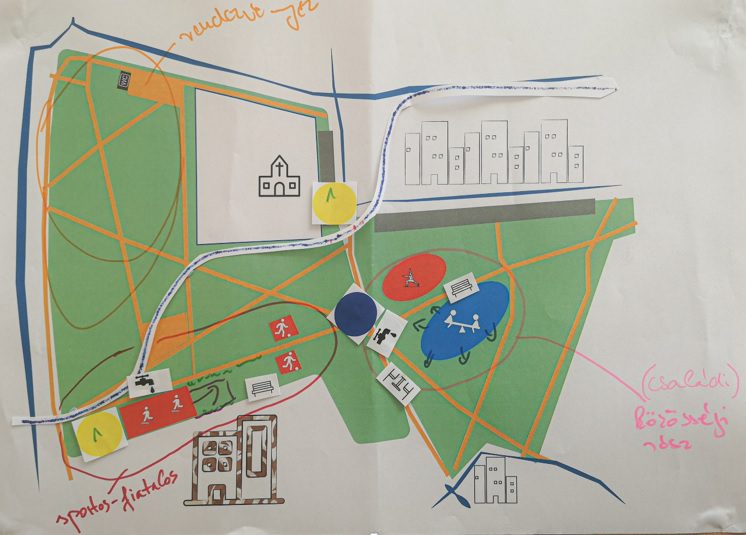
Next year, the running circuit will be completed, which will cover the entire housing estate and cross the park. It is still in the planning stage, but we have already mapped out the current route, indicated by the blue "ribbon" running diagonally from the top right to the bottom left corner. The details of this may still change somewhat, but it was important to at least see the concept and be able to make decisions on the rest of the park accordingly.
In our joint plan, the current structure of the park is unchanged, with three large but not sharply separated areas:
1. Open space and event space
The part facing the roundabout (circled in orange on our map) would not be given a new function, but would retain its current character. This is the area where events occasionally take place (such as the Jutasi picnic this Sunday), so it is not worth installing equipment that would not fit well with this temporary use. This would leave a nice park area free of any "extras".
2. Sporty-football area
The skateboard park and its surroundings are already mainly used by young people, and our joint plan reinforces this. The size of the skate park could be increased, lengthwise, towards the inside of the park, without cutting down trees. It would be surrounded by street furniture that best suits the use habits of young people. This is also the part of the park furthest away from residential buildings, so that the residents of the area would not be disturbed by the presence of the public in the evening (which unfortunately now appears closer to the residential buildings, causing much greater disturbance).
One end of the running circle is right next to the skateboarding track, so we thought it would be appropriate to put a bike storage (indicated by the yellow dot) and a drinking fountain here.
The expansion and increase in the number of mini-football pitches was not considered necessary.
3. (Family) community area
The area we currently use as a playground and fitness park would be enhanced in this form and become a family community area.
This would be achieved by expanding the playground. There is a recurring demand for more swings, climbing frames and balancing equipment, and generally to change the playground so that it offers something for children under 4 and over 8 - currently it caters mainly for the age group between the two. It would be especially nice to have something that would make it unique and different from other playgrounds, as families frequent the playgrounds in the area anyway, and it would be nice if each one had a character. There is also a need for a drinking fountain, and it would be good for community life to have more street furniture (benches, tables) for families.
The expansion of the fitness park was not seen as important, but it was said that it would be good if this whole area could remain unified as an active community area for all ages. An infrastructural suggestion was the placement of a park gate, which would provide the benefits of the presence of water without the operational and user disadvantages of a fountain (not supported by those present).
Next week we will continue to refine the plans, so we are looking forward to seeing you all on 22 September at 17:00 in Kálvin János Park!
Deák Ferenc Ált. School, third time /09.16./
On 16 September, we also held our third planning meeting with local residents in the park in front of the Deák Ferenc Primary School. After a brief summary of what we had done so far, we formed two teams, both with the same task: to "arrange" the parks and their surroundings, using the features and tools we had talked about in the previous sessions. The stylized map shows the current conditions, but we also indicated the possible route of the running circle, stressing that this could change during the design process - but we were also looking forward to participants' comments on this (the maps show the running circle with the red curved line starting from the bottom left and going upwards from the middle). There was only one rule, and that was for team members to discuss each suggestion carefully and come up with a plan that they could all agree on. The work of the two teams is presented below.
First team plan

- area number
In the park in front of the school, the playground would be extended towards the jogging track to make it more accessible to more age groups. New play equipment, benches, litter bins and fencing would be installed. A barefoot trail, which has proved very successful in the Cholnoky housing estate, could also be added. As indicated by the brown dot, trees would also be planted in the area.
- area number
The triangular area to the right of the previous one (on the map), near the school entrance, currently underused, would be used for fitness equipment and a drinking fountain.
- area number
On the edge of the map, next to Aradi street, there is a sports field, the sports function there could be enhanced with ping-pong tables.
- area number
A bicycle storage and a drinking fountain have been placed in the south-east corner of the park, facing the school car park - mainly to serve the users of the running circle.
- area number
In the park behind the kindergarten, this team has been most involved in improving the playground. For example, swings, a sun sail over the sandpit and benches. In the summer heat, a shelter would make the climate of the small park more bearable.
- area number
Between Diósy and Klapka Streets, a "picnic area" would be created where local people would like to come down to lay their blankets and enjoy the natural atmosphere. It would also be necessary to ensure that people in the neighbourhood do not walk their dogs in this area, as this would make it a "mine-free" area.
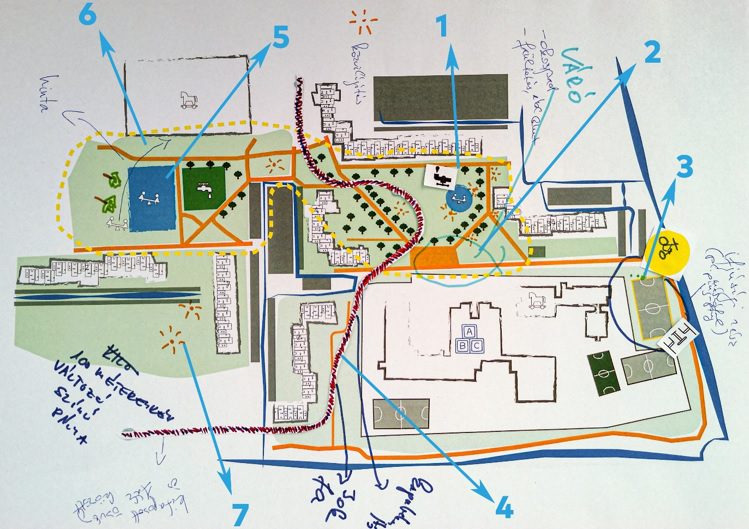
- area number
The second team did not expand the playground next to the school. Although it was acknowledged that there would be a need for additional equipment (mainly swings), fears of increased use and the associated increase in noise meant that it was decided to keep the current state. However, a playground fence would be necessary, with a drinking fountain and lighting nearby. Lighting on the footpath next to the playground would also be needed (the street lighting proposals are indicated by the yellow 'sunflower' icon on the map).
- area number
The area in front of and next to the school entrance already functions as a kind of "waiting room". The team would make this function more comfortable by installing benches, smart benches and possibly additional tree planting to make waiting more comfortable.
- area number
The sports field and its surroundings near Aradi street were also a priority for the second team. This would be the youth section, which would provide a place for young people to come together in a sporty, healthy community. In addition to the renovation of the sports field, a climbing wall, a ping-pong table, seating furniture and a bicycle storage area would be placed here.
- area number
The second team also spent a lot of time on the running circuit. For example, in the area marked 4, we pointed out that there are a lot of trees on the trail and that it might be better to place the running circle right next to the school fence, because they would rather have a sharper bend than have to cut down a tree. We also talked about the colouring of the running circle (and one of our suggestions was to change the colour of the running circle at some regular intervals, for example every 100 metres) and that it would be worth looking at the issue of "mixed use" (e.g. runners, scooters, pedestrians) on the whole circuit.
- area number
The playground behind the kindergarten currently has very poor equipment, so the team would like to expand it. For example, a swing is a must, but other equipment has also been considered. The area next to the playground should be planted with trees to provide additional shade.
- area number
The rope slide is very popular with children, but the noise of the rope slide is disturbing for the residents of the building next door. This element has been moved to the back of the kindergarten and we could even imagine having two of them.
- area number
In the part between Diósy and Klapka streets, many people cross the street to the bus stop, but there is no street lighting, so we have proposed to install street lights here as well.
After the "teamwork", each table presented its own work to the other, so we could immediately see where the two ideas were in agreement and where they differed. There was no time to discuss these in detail this time, so we will do so at the next meeting. This will take place on Thursday 23 September at 17.00. We plan to meet, as usual, in front of the school entrance in the park. However, in case of bad weather, the kindergarten will provide a place for reflection. We look forward to seeing you all!
Campsite park, fourth time /09.21./
On 21 September, we held our fourth planning meeting at Campsite Park. The aim was to go over the draft design from the previous week and to check out ideas that looked good on paper by visiting the site. And at the end of the meeting, we looked at pre-images, gathering inspiration for concrete solutions.
The plan has been modified here and there as a result of the in-depth discussion, as described below.

-
The temporary stage was moved forward to the current paved area to protect the beautiful, healthy trees next to the building. This, in turn, has moved the proposed auditorium towards the interior of the park. We also expressed that we would like to see some modern street furniture next to the event space that could serve as a prominent viewing area during events.
A footpath running lengthwise along the northern side of the park (above on the map) was pushed right up to the edge of the area. This has increased the contiguous green space inside the park. We have moved the children's area roughly along the line of the discontinued path, as we felt that the site we had previously identified could be disruptive during events. We also looked at concrete examples of the equipment that could be used here, and the simple yet unique rope climbing equipment appealed to us the most. Swings were also an option.
In the north-eastern corner (top right), the two shorter paths would be replaced by a path between them, which would also increase the green space and make the park less fragmented. We also looked at preliminary designs for the pavilion in the community area and refined the requirements. We wanted a structure that would provide shelter from rain and sun, be easy to clean, have benches and tables, and be able to seat around 20 people, for example for outdoor club meetings and classes. Security and proper use could be ensured by a CCTV camera.
We were also thinking about a curved bench that could be placed somewhere that could seat a whole class of students at once.
Next time, we will try to establish a prioritisation of the elements of the plan, which will be useful during implementation. We look forward to seeing you all on Tuesday 28 September from 5pm at the Campsite Park (or in case of bad weather at the Agora)!
Park in front of Deák Ferenc Primary School - fourth time /09.24./
-
On 24 September we met for the fourth time in the park in front of the Deák Ferenc Primary School. Our plan was to try to resolve the contentious issues by discussing the differences between the two versions of the plan prepared on the third occasion.
We started the conversation with an exciting topic, but one that stretched the limits of our planning. One of the participants suggested that instead of a running track, the resources available under the EFF project could be used for a number of smaller improvements scattered throughout the housing estate. We spent a long time on the issue, arguing for and against, and then concluded by pointing out that the municipality had already taken the decision on the running track proposed by the experts, and that the planning was at an advanced stage, so that (as 2023 was very close) it would jeopardise its implementation if we were to start arguing on the basis of the funds again. So, in the community planning of the park in front of the school, as we have said before, we should treat the running circle as a given and turn our attention to other needs.
We then turned our attention to the playground in the park in front of the school. The previous time team one would have extended the playground, team two would not. Both agreed on fencing around the playground, but team one thought that it would be worth fencing around an area larger than the playground to create a dog-free lawn area. So that was our starting point for the fourth session, where the discussion quickly took an interesting turn. It was finally agreed that more play equipment should be added to the park, but a recent suggestion was that this should not be done by extending the existing playground area, but by creating a new age-specific playground in a triangular area close to the school, currently unused. In addition to the play equipment for younger children, there would also be enough space to accommodate the fitness equipment proposed by the first group. In connection with the playground, it was also suggested that it might be worth considering the inclusion and development of the Berkenye Nature Trail.
There was not complete agreement among the participants on fencing. The fencing around the playground was acceptable to all, but the separation of the grassed area was not to everyone's liking. The advantages and disadvantages were weighed up - the advantages were safety (no children running out, no damage to equipment), cleanliness (especially the prevention of dog fouling), and the elimination of noisy night-time play; the disadvantages were the public space that had to be cut up, and the costs of setting up, running and maintaining the playground. In the end, on this topic, it was only noted that, although there was a majority in favour of fencing at the meeting, there was no unanimity of opinion on the issue.
We also discussed the future of the ropeslide in the park behind the kindergarten. It was agreed that moving it behind the nursery should be discussed with the nursery, and it was also wondered whether the higher ground would be a more acoustically prominent location for the equipment. In the end, our main conclusion was that, since the biggest problem with the rope slide is its loud, banging operation, perhaps we should not change the location, but first investigate whether the noise impact could be reduced by upgrading the equipment.
At the end of our time, we agreed to continue our joint reflection on the choice of instrument types for the next session. The fifth meeting will take place on 30 September at 17.00 in the park in front of the school!
Agora)!
Campsite park, fifth time /09.28./
On 28 September, we held the fifth, final planning session for the Campsite Park. The meeting was the first time we reviewed the previously prepared plan. Having established that everyone present was happy with their 'work' and that no one wanted any further changes, we moved on to our final task: prioritisation.
Prioritisation is the process of ranking our development proposals for the park. This can come in handy when there may not be sufficient funds to complete the whole project at once later on. It is good to know which elements are more urgent. Each participant set their own priorities, which were then discussed and presented to each other to establish the final order. This looks as follows:
- The most important issues were the themes of the event space, especially the reversibility of the stage. This is an issue that is very important for both the Agora and the residents of the adjacent building. This would of course be the case if it could be implemented together with the design and shading of the event space....
- Green space issues came second. Most emphasis was placed on "external" fencing with hedges, but closely followed by increasing internal transparency.
- In third place was the improvement of the park infrastructure - the creation and expansion of benches, litter bins, drinking fountains and bicycle storage.
- These were followed in roughly equal measure by the community-building features, namely the children's area and the community park area.
- Modern furniture that doubles as an auditorium completed the line.
Of course, we hope that all the features and facilities envisioned in the community planning process can be added to the Campsite Park in the future, but it was still exciting to see which elements were most important to whom.
This concludes the most active phase of the Community planning process. The sixth event will take place on Saturday afternoon 2 October, as previously planned, in the form of a planning presentation. On this day, Agora will host a Hungarikums-related event for the people of Veszprém, but the programme will also include us and the newly completed design proposal for the Campsite Park! We hope we will have the opportunity to present to as many people as possible the work we have done together over the past month! After the presentation, and taking into account any comments that may be received, it will be up to the landscape architects to turn the vision dreamed up by the locals into the actual plans. Thank you to everyone who has been involved in the community planning for Campsite Park!
János Kálvin Park, fifth time /09.29./
On the afternoon of 29 September, we held our fifth meeting in János Kálvin Park. The main theme of the meeting was playgrounds, and we knew from experience that most of the parents in the area, who are experts on the subject, can usually only devote a few minutes of undisturbed attention to planning with their young child. For this reason, we were on the spot hours before the announced time, and one by one we tried to get their opinions on the important issues, taking them away from the playground for only a short time. The ideas gathered were then collated and discussed at the meeting, which started at 5pm.
Perhaps the most important finding is that the parents and grandparents interviewed all support the extension of the playground, confirming what has been said at previous planning sessions. Opinions were divided as to which age group most needs the new equipment (not irrespective of the age of the children or grandchildren), but the majority view was in line with what we had said a few times before, that the youngest (0-4 years) and the older (8-12 years) are now in a less favourable position.
As far as the specific equipment is concerned, the most important thing would be to install new swings in the playground, both with baby seats for the smallest children and with traditional seats. Many other suggestions for equipment came up during the discussions, the most popular being a (recessed) trampoline, a creative (multi-directional, multi-purpose) climbing frame and a house house that is very popular with the little ones. But there was also a lot of support for a balancing act, a seesaw, a climbing castle, and suggestions for a football pitch on the grass, a barefoot path or even a crate for sanding equipment. A pump track was even suggested as an idea to introduce the youngest and the older children to the world of cycling.
In addition to play equipment, there was also a lot of talk about additional infrastructure. It went without saying that litter bins, drinking fountains, CCTV cameras, benches - with tables in some places - would be needed, and a sun sail would be welcome above the plastic paving, as the trees on this side are still a long way from reaching the size needed to provide protection from the afternoon sun.
We also talked a lot about fencing in the playground. It was clear that those with older children generally feel less need for this physical protection, but parents and grandparents of younger children are worried that their child could easily run out onto the road. There were also many who argued in favour of fencing because they found that dog owners were not all careful about where their pets were poking; and many also mentioned the problem of people drinking and leaving broken glass and cigarette butts in their wake in the evening, which could perhaps also be kept out by fencing. For these reasons, the vast majority of those interviewed and present at the meeting were in favour of a fence, and we decided to ask the designers to come up with a concept.
Our next session will take place on 6 October, when we will move back to the skateboarding area, as our main focus will be on the sporty-youth area. Everyone is welcome to join us from 17.00!
Park in front of Deák Ferenc Primary School, fifth time /09.30./
On 30 September, we held our fifth planning meeting in the park in front of the school. As there were new participants (or those who had skipped the previous sessions), we started the meeting with a summary of the previous sessions - and found that this summary was getting longer, as it had to recount the events of four sessions...
The aim of the planning day was to finalise the issues left open a week earlier and to propose specific equipment for the playgrounds. But first, we listened to people's views on what has been done so far, and to those who had new ideas after hearing the summary. We talked about the beauty and problems of dog park use, the public toilets, and even noted that the playground is quite windy, and wondered if the landscape architects had any suggestions to mitigate this, for example by planting.
The playgrounds of the two parks were decorated in a playful way - participants could choose the one they liked best from a selection of pictures and then place it under the name of the playground with a little explanation. To summarise what we heard:
- In the playground of the park behind the kindergarten, it is important to increase the offer for older people. We have proposed, for example, the installation of a seesaw and a "multifunctional" play castle, in addition to the swing (and of course the sun sail) mentioned earlier.
- In the area in front of the school, as we discussed on the previous occasion, there would actually be two playgrounds. Here it would be important to have more opportunities for all ages, and our concept was to have one for the younger children and one for the older ones, so that children of different ages could play in a more 'uncluttered' way. The proposed equipment included swings, a spring-loaded seesaw, a house-house, a sandpit, as well as the barefoot path that had been suggested earlier, and the climbing frame (more complex than the one currently in use) suggested by school children on previous occasions. A sun sail was also requested. Looking at the pictures, another idea that came to mind was that the two playgrounds could be linked by a colourful surface on which, for example, a jumping school or other fun things could be drawn. The idea of fitness equipment for the area closer to the school was also mooted, but the area's MP told us that there are already plans to create such a park not far away.
As on the previous occasion, the biggest problem was the fencing. Once again, we listed the pros and cons, and although the majority of those present were in favour of the perimeter fence, we were not bold enough to decide the issue by voting. In the end, we decided to wait for the landscape architects' ideas to see if there was a compromise solution that would meet the needs.
Next time we would like to walk the "ground" and finalise where we are going with our proposals. We look forward to seeing you all on 7 October from 17.00 in the park in front of Deák school!
Campsite park, sixth time /10.02./
The sixth planning meeting of the Campsite Park was held on Saturday afternoon, 2 October. With the plan having been put together at the previous five meetings, all that remained was to present it to as many local residents and interested parties as possible. The Hungarikum Weekend was an excellent opportunity to do this, with many people from the surrounding area and beyond visiting the park that day. In this way, those who had not been able to attend the previous events were able to see and comment on the plans we had made together. In the course of the afternoon, we talked to around half a hundred people about the renewal of the Campsite Park and were pleased to see that the concept we had dreamt up together was well received.
Our proposal will soon be handed over to the architects, who will be able to draw up the technical plans on the basis of our dialogue. We will also report on the outcome of their work.
János Kálvin Park, sixth time /10.06./
On 6 October, because of the drizzling rain, we decided to hold the sixth event in the library, on the theme of improving the area previously known as the "sporty-footy part", the skatepark environment. Unfortunately, because of the weather, the young people whose opinions would make the most difference in this planning matter were not very likely to come to the discussion. For this reason, we decided to dedicate the meeting to a questionnaire to reach out to skatepark users, and we also talked about good examples from home (one of the mothers said that there was an extreme park in Tapolca, for example, which we could use the experience of.)
Questionnaire on the skatepark on this link available until 20 October, and responses are welcome!
Park in front of Deák school, sixth time /10.07./
On 7 October, we held a plan finalisation event in the park in front of Deák Ferenc Primary School. The "core members" of our planning team from Elbe came, so we continued our previous discussions and went around our planning area to check our ideas once again on the spot.
By the playground in front of the school, we again pondered the question of the fence, and wondered whether it might not be better to plant a hedge on the north side facing the wind. We looked at the playground equipment and the state of the paving and concluded that perhaps some rearrangement could be made to accommodate some equipment here. We came to the conclusion that it might be more appropriate to set up toys for the smaller children in this area, while the new play area (the triangular grass area) would have toys for the larger children, as this would allow the louder children to play further away from the already echoing buildings.
We also walked to the sports field, where we visited the youth area. The entrance to the pitch and the paving will have to be replaced, and we saw that there would probably not be room for a ping-pong table, if only because of the almost constant wind, but that the climbing wall, the seating area, could be moved to the inner side of the area. It would also be good to have lights to illuminate the pitch, but it is important that these are correctly positioned and do not shine through the windows of the surrounding flats.
From here we walked towards the park behind the kindergarten. In the meantime, we looked at the walkways, the green grove at the junction of the two buildings, and then walked up to the promenade behind the nursery. Here, we finally rejected the earlier proposal to install the rope slide, as it would not be possible next to the valuable double tree line. However, we could imagine a bench in this area.
Then we looked at the playground. Confirming our previous observations, we also thought that we could use the natural features to create a slide by slightly extending the area, which would certainly become a favourite with the children in the area. We also looked at the rope slide, and our impression was confirmed that a small improvement to the device would go a long way towards reducing its disturbing noise.
We still like the community space adjacent to the playground, so we didn't propose any changes - we just thought it would be worthwhile to add some plants to the existing pergolas. We then walked over to the other side of the Diósy u. building, looked at the path that needs street lighting, and then headed back to the park in front of the school. On the way, we looked at the "trail" of the running track next to the school and found that there was room for new paving where the excavation near the fence had been.
Back in front of the school, we talked about which elements were most important to whom, and thanked them for their work over the past weeks, and said that we would be holding a joint presentation of the plan, including community planning for the rest of the estate, at the end of October. The date of this will be announced later, and we hope that as many people as possible will come!

On Tuesday, 26 October 2021, at 17:00 at the Agóra Veszprém Cultural Centre, we held a presentation of the plan as a closing event of the Jutasi Community Planning.
At the event, we presented the plans that we had dreamt up together with the residents.
Community planning has started a dialogue, a community building activity, which we want to continue in community development.
Community design opportunities in pictures
More information and related sites:
Veszprém - Connect! - community planning on Jutasi út (veszprem.hu)
2023 EKF - Running circle at the Jutasi housing estate - Veszprém Kukac (veszpremkukac.hu)
Joint planning with the residents of the housing estate (veszport.hu)
Community planning - The residents of the Jutasi Road housing estate are consulted | VEOL
The Jutasi Road housing estate gets the new 3,500-metre runway | 82nullanulla.hu
Dear Interested Party!
Find out the results of the survey on the Jutasi housing estate.




